Hampi
(→Granaries, Hampi – Remnants of Ancient Storages) |
(→UNESCO’s citation) |
||
| (One intermediate revision by one user not shown) | |||
| Line 118: | Line 118: | ||
Entry Fee: Free | Entry Fee: Free | ||
| − | History of the Yantrodharaka Hanuman Temple | + | |
| + | '''History of the Yantrodharaka Hanuman Temple''' | ||
According to some legends, this temple is built on the place where Hanuman and Lord Ram met for the first time. Others believe that Sri Vyasaraja used to pray to Lord Hanuman in this place by drawing an image of Lord Hanuman on the rocks. | According to some legends, this temple is built on the place where Hanuman and Lord Ram met for the first time. Others believe that Sri Vyasaraja used to pray to Lord Hanuman in this place by drawing an image of Lord Hanuman on the rocks. | ||
By the time he finished his prayers, the picture would have disappeared. When this happened for 12 days in a row, he pleaded with Lord Hanuman to appear before him. When the Lord appeared, he asked Sri Vyasaraja to constrain him in a six-sided amulet and build a temple in the area. | By the time he finished his prayers, the picture would have disappeared. When this happened for 12 days in a row, he pleaded with Lord Hanuman to appear before him. When the Lord appeared, he asked Sri Vyasaraja to constrain him in a six-sided amulet and build a temple in the area. | ||
| + | |||
'''The Temple Architecture ''' | '''The Temple Architecture ''' | ||
| Line 139: | Line 141: | ||
A short climb ahead of the Temple is another small temple dedicated to an incarnation of Lord Vishnu. | A short climb ahead of the Temple is another small temple dedicated to an incarnation of Lord Vishnu. | ||
| − | |||
| − | |||
| − | |||
| − | |||
| − | |||
| − | |||
| − | |||
| − | |||
| − | |||
| − | |||
| − | |||
| − | |||
| − | |||
| − | |||
===The Jewel of Hampi- The Stone Chariot=== | ===The Jewel of Hampi- The Stone Chariot=== | ||
| Line 185: | Line 173: | ||
Best time to visit: From November to February | Best time to visit: From November to February | ||
| − | History of the Chariot | + | |
| + | '''History of the Chariot''' | ||
The chariot was built by King Krishnadevaraya of the Vijayanagara Empire during the 16th century, who got fascinated with the Konark Sun temple chariot while fighting a battle in Odissa. The chariot is meant to represent the beauty and artistic perfection of the Empire. An interesting folklore emanates from the Hampi chariot as villagers believe that the world would come to a halt when the chariot moves from its place. It has come to have a sacrosanct presence and is internationally recognized as a world heritage site even by the UNESCO. | The chariot was built by King Krishnadevaraya of the Vijayanagara Empire during the 16th century, who got fascinated with the Konark Sun temple chariot while fighting a battle in Odissa. The chariot is meant to represent the beauty and artistic perfection of the Empire. An interesting folklore emanates from the Hampi chariot as villagers believe that the world would come to a halt when the chariot moves from its place. It has come to have a sacrosanct presence and is internationally recognized as a world heritage site even by the UNESCO. | ||
| + | |||
'''Architecture''' | '''Architecture''' | ||
| Line 206: | Line 196: | ||
Tourists normally spend about 3 hours at the complex. | Tourists normally spend about 3 hours at the complex. | ||
| − | |||
| − | |||
| − | |||
| − | |||
| − | |||
| − | |||
| − | |||
| − | |||
| − | |||
| − | |||
| − | |||
| − | |||
| − | |||
| − | |||
===Royal Enclosure – Home of Erstwhile Kings and Queens=== | ===Royal Enclosure – Home of Erstwhile Kings and Queens=== | ||
| Line 282: | Line 258: | ||
Today, only the stone platforms remain to mark where palaces and building once stood. Since many structures were made of wood, this area seems to have been easier to destroy than other parts of Hampi with complete stone structures. Though it may look like an empty area at first glance, a closer look will bring out many interesting relics and details. | Today, only the stone platforms remain to mark where palaces and building once stood. Since many structures were made of wood, this area seems to have been easier to destroy than other parts of Hampi with complete stone structures. Though it may look like an empty area at first glance, a closer look will bring out many interesting relics and details. | ||
| − | |||
| − | |||
| − | |||
| − | |||
| − | |||
| − | |||
| − | |||
| − | |||
| − | |||
| − | |||
| − | |||
| − | |||
| − | |||
| − | |||
| − | |||
| − | |||
| Line 370: | Line 330: | ||
[[File: Sasivekalu Ganesha, Hampi. Image courtesy Paawak.jpg|Sasivekalu Ganesha, Hampi. Image courtesy Paawak <br/> From: [https://www.karnataka.com/hampi/sasivekalu-ganesha-temple/ APRIL 24, 2017 BY MADUR: ''Karnataka.com'']|frame|500px]] | [[File: Sasivekalu Ganesha, Hampi. Image courtesy Paawak.jpg|Sasivekalu Ganesha, Hampi. Image courtesy Paawak <br/> From: [https://www.karnataka.com/hampi/sasivekalu-ganesha-temple/ APRIL 24, 2017 BY MADUR: ''Karnataka.com'']|frame|500px]] | ||
| − | |||
| − | |||
| − | |||
| − | |||
| − | |||
| − | |||
| − | |||
| − | |||
| − | |||
| − | |||
| − | |||
| − | |||
| − | |||
| − | |||
| − | |||
| − | |||
===Achyuta Raya Temple, Hampi=== | ===Achyuta Raya Temple, Hampi=== | ||
| Line 433: | Line 377: | ||
There is a Mandapa which is a marriage hall of the Gods and the Goddesses for the yearly nuptials. | There is a Mandapa which is a marriage hall of the Gods and the Goddesses for the yearly nuptials. | ||
| − | |||
| − | |||
| − | |||
| − | |||
| − | |||
| − | |||
| − | |||
| − | |||
| − | |||
| − | |||
| − | |||
| − | |||
| − | |||
| − | |||
| − | |||
| − | |||
| − | |||
| − | |||
===Dasara Dibba – A Wonderful Stone Platform=== | ===Dasara Dibba – A Wonderful Stone Platform=== | ||
| Line 532: | Line 458: | ||
[[File: Virupaksha Temple, Hampi. Image courtesy Vedamurthy J.jpg|Virupaksha Temple, Hampi. Image courtesy Vedamurthy J <br/> From: [https://www.karnataka.com/hampi/virupaksha-temple/ APRIL 22, 2017 BY RAGGI MUDDE: ''Karnataka.com'']|frame|500px]] | [[File: Virupaksha Temple, Hampi. Image courtesy Vedamurthy J.jpg|Virupaksha Temple, Hampi. Image courtesy Vedamurthy J <br/> From: [https://www.karnataka.com/hampi/virupaksha-temple/ APRIL 22, 2017 BY RAGGI MUDDE: ''Karnataka.com'']|frame|500px]] | ||
| − | |||
| − | |||
| − | |||
| − | |||
| − | |||
| − | |||
| − | |||
| − | |||
| − | |||
| − | |||
| − | |||
| − | |||
| − | |||
===Saraswati Temple, Hampi: An Erstwhile Glory=== | ===Saraswati Temple, Hampi: An Erstwhile Glory=== | ||
| Line 568: | Line 481: | ||
[[File: Saraswati Temple, Hampi. Image courtesy Utsavullas33.jpg|Saraswati Temple, Hampi. Image courtesy Utsavullas33 <br/> From: [https://www.karnataka.com/hampi/saraswati-temple/ APRIL 22, 2017 BY RAGGI MUDDE: ''Karnataka.com'']|frame|500px]] | [[File: Saraswati Temple, Hampi. Image courtesy Utsavullas33.jpg|Saraswati Temple, Hampi. Image courtesy Utsavullas33 <br/> From: [https://www.karnataka.com/hampi/saraswati-temple/ APRIL 22, 2017 BY RAGGI MUDDE: ''Karnataka.com'']|frame|500px]] | ||
| − | |||
| − | |||
| − | |||
| − | |||
| − | |||
| − | |||
| − | |||
| − | |||
| − | |||
| − | |||
| − | |||
| − | |||
| − | |||
| − | |||
===Gejjala Mantapa, Hampi – An Ornate Platform=== | ===Gejjala Mantapa, Hampi – An Ornate Platform=== | ||
| Line 636: | Line 535: | ||
Standing on a patch of greenery, this monument is a wonderful example of the craftsmanship of the artisans of that era. | Standing on a patch of greenery, this monument is a wonderful example of the craftsmanship of the artisans of that era. | ||
| − | |||
| − | |||
| − | |||
| − | |||
| − | |||
| − | |||
| − | |||
| − | |||
| − | |||
| − | |||
| − | |||
| − | |||
| − | |||
| − | |||
| − | |||
| − | |||
| − | |||
| − | |||
| − | |||
===Yeduru Basavanna, Hampi – An Ancient Sculpture=== | ===Yeduru Basavanna, Hampi – An Ancient Sculpture=== | ||
| Line 709: | Line 589: | ||
Today the structure is in a semi-ruined condition. Though crude in its form and appearance, the monolith bull is a huge draw for tourists who visit Hampi. | Today the structure is in a semi-ruined condition. Though crude in its form and appearance, the monolith bull is a huge draw for tourists who visit Hampi. | ||
| − | |||
| − | |||
| − | |||
| − | |||
| − | |||
| − | |||
| − | |||
| − | |||
| − | |||
| − | |||
| − | |||
| − | |||
| − | |||
| − | |||
| − | |||
| − | |||
| − | |||
| − | |||
| − | |||
| − | |||
| − | |||
| − | |||
===Zenana Enclosure, Hampi – Private Place for Royal Ladies=== | ===Zenana Enclosure, Hampi – Private Place for Royal Ladies=== | ||
| Line 822: | Line 680: | ||
However, the one structure that is in an almost intact condition is the Lotus Mahal. It is not only the main attraction of the Zenana Enclosure, but also one of the most beautiful structures found among the ruins in Hampi. | However, the one structure that is in an almost intact condition is the Lotus Mahal. It is not only the main attraction of the Zenana Enclosure, but also one of the most beautiful structures found among the ruins in Hampi. | ||
| − | |||
| − | |||
| − | |||
| − | |||
| − | |||
| − | |||
| − | |||
| − | |||
| − | |||
| − | |||
| − | |||
| − | |||
| − | |||
| − | |||
| − | |||
| − | |||
===Varaha Temple, Hampi – An Impressive Structure=== | ===Varaha Temple, Hampi – An Impressive Structure=== | ||
| Line 905: | Line 747: | ||
Recently the Archaeological Survey of India has partially renovated the temple in its attempt to preserve this historical structure. | Recently the Archaeological Survey of India has partially renovated the temple in its attempt to preserve this historical structure. | ||
| − | |||
| − | |||
| − | |||
| − | |||
| − | |||
| − | |||
| − | |||
| − | |||
| − | |||
| − | |||
| − | |||
| − | |||
| − | |||
| − | |||
| − | |||
| − | |||
| − | |||
| − | |||
| − | |||
| − | |||
| − | |||
| − | |||
| − | |||
===Uddana Veerabhadra Temple, Hampi – Shrine for a Cult Deity=== | ===Uddana Veerabhadra Temple, Hampi – Shrine for a Cult Deity=== | ||
| Line 1,000: | Line 819: | ||
The priests who perform puja at this temple belong to the Lingayath community, which is a deviation from the tradition of the Brahmin community performing the puja rites everywhere. | The priests who perform puja at this temple belong to the Lingayath community, which is a deviation from the tradition of the Brahmin community performing the puja rites everywhere. | ||
| − | |||
| − | |||
| − | |||
| − | |||
| − | |||
| − | |||
| − | |||
| − | |||
| − | |||
| − | |||
| − | |||
| − | |||
| − | |||
| − | |||
| − | |||
| − | |||
| − | |||
===Stone Trough, Hampi – Remnant of the Ancient Times=== | ===Stone Trough, Hampi – Remnant of the Ancient Times=== | ||
| Line 1,065: | Line 867: | ||
It is a plain trough that can be easily missed by visitors who are not aware of its existence or may be considered as a casual rock object lying around. However, the length of the trough often attracts visitors to give it a second look and try to realise its purpose within the Royal Enclosure. | It is a plain trough that can be easily missed by visitors who are not aware of its existence or may be considered as a casual rock object lying around. However, the length of the trough often attracts visitors to give it a second look and try to realise its purpose within the Royal Enclosure. | ||
| − | |||
| − | |||
| − | |||
| − | |||
| − | |||
| − | |||
| − | |||
| − | |||
| − | |||
| − | |||
| − | |||
| − | |||
| − | |||
| − | |||
| − | |||
| − | |||
| − | |||
| − | |||
| − | |||
| − | |||
| − | |||
| − | |||
| − | |||
===Stone Doors, Hampi – Remnants of a Glorious Past=== | ===Stone Doors, Hampi – Remnants of a Glorious Past=== | ||
| Line 1,140: | Line 919: | ||
The impressive engravings on both sides of the door attract tourists towards this exceptional remnant from the Vijayanagara period. | The impressive engravings on both sides of the door attract tourists towards this exceptional remnant from the Vijayanagara period. | ||
| − | |||
| − | |||
| − | |||
| − | |||
| − | |||
| − | |||
| − | |||
| − | |||
| − | |||
| − | |||
| − | |||
| − | |||
| − | |||
| − | |||
| − | |||
| − | |||
| − | |||
| − | |||
| − | |||
| − | |||
| − | |||
===Pushkaranis, Hampi – The Sacred Water Tanks of the Ancient Times=== | ===Pushkaranis, Hampi – The Sacred Water Tanks of the Ancient Times=== | ||
| Line 1,242: | Line 1,000: | ||
The pushkaranis were an integral part of the lives of the people of Hampi during the ancient times. Today they are part of the ruins of Hampi that attracts visitors from all over the world. | The pushkaranis were an integral part of the lives of the people of Hampi during the ancient times. Today they are part of the ruins of Hampi that attracts visitors from all over the world. | ||
| − | |||
| − | |||
| − | |||
| − | |||
| − | |||
| − | |||
| − | |||
| − | |||
| − | |||
| − | |||
| − | |||
| − | |||
| − | |||
| − | |||
| − | |||
| − | |||
===Pan Supari Bazaar, Hampi – Tracing a Long Lost Market Place=== | ===Pan Supari Bazaar, Hampi – Tracing a Long Lost Market Place=== | ||
| Line 1,320: | Line 1,062: | ||
Even the gateway near the market place is in a ruined condition and only the basement remains today. | Even the gateway near the market place is in a ruined condition and only the basement remains today. | ||
| − | |||
| − | |||
| − | |||
| − | |||
| − | |||
| − | |||
| − | |||
| − | |||
| − | |||
| − | |||
| − | |||
| − | |||
| − | |||
| − | |||
| − | |||
| − | |||
| − | |||
| − | |||
===Granaries, Hampi – Remnants of Ancient Storages=== | ===Granaries, Hampi – Remnants of Ancient Storages=== | ||
| Line 1,543: | Line 1,267: | ||
Specific long, mid and short term goals for ensuring effective management of the property have been identified and their implementation processes are in various stages. The periodic review and update of management tools including the Master Plan, the Base Map on the GIS platform, the Conservation Plan, the Risk Preparedness Plan, the Public Use plan, and other tools to ensure sustainable development of the local community and also reduce the risk from natural and human made disaster in different areas of the property, is critical to ensure the sustainability of the management system. Long-term goals include internal capacity building and adoption of a new systematic approach where actions are coordinated and participatory. Sustained funding will be essential to ensure an operational system and the allocation of resources for the implementation of projects for the conservation and management of the diverse elements of the property. | Specific long, mid and short term goals for ensuring effective management of the property have been identified and their implementation processes are in various stages. The periodic review and update of management tools including the Master Plan, the Base Map on the GIS platform, the Conservation Plan, the Risk Preparedness Plan, the Public Use plan, and other tools to ensure sustainable development of the local community and also reduce the risk from natural and human made disaster in different areas of the property, is critical to ensure the sustainability of the management system. Long-term goals include internal capacity building and adoption of a new systematic approach where actions are coordinated and participatory. Sustained funding will be essential to ensure an operational system and the allocation of resources for the implementation of projects for the conservation and management of the diverse elements of the property. | ||
| + | |||
| + | =After 1947= | ||
| + | ==1947- 2019 == | ||
| + | [https://epaper.timesgroup.com/Olive/ODN/TimesOfIndia/shared/ShowArticle.aspx?doc=TOIDEL%2F2019%2F02%2F09&entity=Ar01604&sk=FC04CCC0&mode=text&fbclid=IwAR0xbNWtay6W-ZEiQvpLmvNP-a6t8cMc3sXNh6uog5KY5oBrNNWj_0viSGQ Sangamesh Menasinakai, Hampi stands on more than the pillars miscreants pulled down, February 9, 2019: ''The Times of India''] | ||
| + | |||
| + | [[File: Hampi.jpg|Hampi <br/> Photo: Shivashankar Banagar <br/> From: [https://epaper.timesgroup.com/Olive/ODN/TimesOfIndia/shared/ShowArticle.aspx?doc=TOIDEL%2F2019%2F02%2F09&entity=Ar01604&sk=FC04CCC0&mode=text&fbclid=IwAR0xbNWtay6W-ZEiQvpLmvNP-a6t8cMc3sXNh6uog5KY5oBrNNWj_0viSGQ Sangamesh Menasinakai, Hampi stands on more than the pillars miscreants pulled down, February 9, 2019: ''The Times of India'']|frame|500px]] | ||
| + | |||
| + | |||
| + | ''Once obscure pilgrimage site now hogs global spotlight'' | ||
| + | |||
| + | Along a distance of 12 km eastwards from the city of Hospet in Karnataka, local residents have a term for what lies at the end of the journey: ‘haalu Hampi’. It means ‘ruined Hampi’. For generations, the 14th century capital of the Vijaynagara Empire, with extraordinary architectural and historical treasures, had been just a place of ruin and desolation. But 30 years after it saw a revival in tourism, Hampi is now the focus of global attention, with the New York Times placing it second in the list of must-visit places in the world. | ||
| + | |||
| + | On March 1, 2018, under the Centre’s regional air connectivity scheme UDAN, flights started from Bengaluru to Ballari, from where Hampi is 62 km away. This is expected to increase connectivity to the monument complex. But all this – and an international profile -- has not come easily for Hampi. | ||
| + | |||
| + | The site is vast, spread over 41 sq km, containing more than 1,800 buildings, markets, fortifications, ponds and temples, with a history of settlement going back to the Mauryan Empire. Ashokan rock edicts have been found at Nittur and Udegolam, near the city complex. In 1565, a coalition of Muslim sultanates defeated Vijayanagara and sacked the city. It was only in 1856 that it was re-discovered, by Alexander Greenlaw of the East India Company. | ||
| + | |||
| + | In later years, Hampi became mainly a pilgrimage site for the people of the region. The only other visitors were those familiar with the history of the place, and there were little employment opportunities for anybody. | ||
| + | |||
| + | “When I was young, the only time my parents could earn well was during festivals. We could get about Rs 2,000 during these times -- a lot of money in the 1980s. The rest of the year, it was a hand-to-mouth existence,” said A Krishnam Raju, whose parents emigrated to Hampi to sell incense sticks. | ||
| + | |||
| + | “Things changed from 1990 onwards. Now there are at least 100 members of 30 families related to me in the hospitality industry here,” Raju, who owns a restaurant, added. | ||
| + | |||
| + | In 1988, UNESCO declared Hampi a world heritage site, which led to a boost in the number and type of tourist arrivals. By then, Dutch artist Robert Geesink had been living in the area for nearly two decades, and would stay for two more decades. “He motivated us to consider expanding our services to tourists. Hampi was becoming more than a pilgrimage spot. Now I have 30 employees at my restaurant,” Raju added. | ||
| + | |||
| + | Sripada Pathikonda, secretary, Tourism Entrepreneurs’ Association, Hosapete, said there were 6 or 7 hotels in Hosapete a decade ago. “Now we have 50 and can accommodate 2,000 guests per day. Many unauthorised home stays and hotels have also come up,” he added. | ||
| + | |||
| + | ASI has recognized 57 monuments here as World Heritage Sites and state archaeological department another 1,800. ASI has also formed a separate Hampi Mini Circle from Sept 5, 2014 for up-keep. | ||
| + | |||
| + | Hampi may have seen the most remarkable turnaround for any tourist site in the country in the recent past, but problems remain. A video which was widely circulated online at the beginning of February showed some youths toppling reconstructed pillars near a Vishnu temple. Locals have alleged that lax protection of the sites by ASI is to blame. A team of archaeologists, police officers and district administration officials have surveyed the damage and recommended that the ASI increase the number of CCTV cameras in the complex and tighten security arrangements. | ||
| + | |||
| + | Locals have other issues as well with the manner in which the site is administered. “Hampi was protected by local residents much before ASI was formed. Now citing ASI norms and alleging illegal activities, authorities are trying to evict us,” said M Swati Singh of Hampi gram panchayat, which includes 73 individual households and claims ownership of Virupaksha temple, a protected monument. Villagers have gone to court against the move. | ||
| + | |||
| + | In other cases, experts have expressed objections. Fencing has been erected around many sites and monuments. “This looks odd and diminishes the look of heritage sites. There is a stone wall near a site called Queen’s Bath. If you put up fencing between connected sites, it throws away context and meaning,” said Vasudevan CS, professor of ancient history and archaeology, Kannada University at Hampi. | ||
Latest revision as of 20:30, 9 February 2019
[edit] Hampi
This article has been extracted from THE IMPERIAL GAZETTEER OF INDIA , 1908. OXFORD, AT THE CLARENDON PRESS. |
Note: National, provincial and district boundaries have changed considerably since 1908. Typically, old states, ‘divisions’ and districts have been broken into smaller units, and many tahsils upgraded to districts. Some units have since been renamed. Therefore, this article is being posted mainly for its historical value.
Village in Bellary District, Madras. Site of Vijavanagar.
[edit] 10 Less Known Facts about Hampi
APRIL 20, 2017 BY MADUR: Karnataka.com
Hampi is the town of ruins of Vijayanagara Empire. It is one of the UNESCO recognized world heritage sites in India. The place is one of India’s most known archaeological destinations. The town of Hampi is in a secluded area, with royal residences, temples, towers, roads, and statues, all spread over a massive area. The heritage site is located near the River Tungabhadra. The famous tourist destination never fails to attract travelers all around the world throughout the year.
Here are a few less known facts about Hampi. These facts about Hampi are enough to make you plan a visit to this incredible place.
1. Musical pillars
A standout amongst the most appealing structures is the Vittala Temple. This antiquated temple is famous for its marvelous architecture. It is also known for another extraordinary architectural marvel- 56 melodic columns or the musical pillars. These pillars create melodic sounds when tapped delicately. The most intriguing thing is that the columns are constructed using stones. The melodic mainstays of Vittala Temple are also called SAREGAMA pillars.

From: APRIL 20, 2017 BY MADUR: Karnataka.com
2. Architect tactics of those times
Hampi is scattered with ruins of giant monuments of the Vijayanagar Empire which were built with granite rock stones existed in abundance in the town. There is an interesting tactic that the artists of those times followed to cut these gigantic stones and changed them into bits of art pieces in that old age. When a rock was cut, a sequence of holes was made on the stone’s surface. Then the dry wooden pieces were pegged into the stone. Water was poured over the pegs such that they are soaked well in it. As the wooden pegs are completely doused with the water, their size expands and the small pegs cause the stone to split and break apart due to the mounting pressure inside.
3. The name and the age of Hampi
There is a typical misguided judgment that Hampi was built up by the Vijayanagara Empire. Nonetheless, the primary historical record of settlement in Hampi goes back to 1st Century. Evidence shows that the district of Hampi was under the governor of Ashokan Kingdom amid the third century BC.
Hampi customarily known as Kishkinda-kshetra, Pampa-kshetra or Bhaskara-kshetra is obtained from Pampa, an old name of the River Tungabhadra. The city of Hampi is located at the southern bank of this river. The name Hampi is an adaptive form of the Kannada Hampe (derived from Pampa). This is indeed an interesting fact about Hampi, isn’t it?

From: APRIL 20, 2017 BY MADUR: Karnataka.com
4. The Archaeological Museum
The Archaeological Museum in the town shows numerous things from the vestiges and ruins of the empire era. These incorporate many pictures of Durga, and furthermore the Lakshmi statue juxtaposed with the solid Narasimha of Vijayanagara. In the courtyard of the historical museum, there is a huge model of the whole town of Vijayanagar. Pictures and detailed history of early and ancient man in the area can likewise be found in it. Not the majority of guests know about this museum. It is situated close to the town of Hosapete within the ruins of the Vijayanagara Empire.
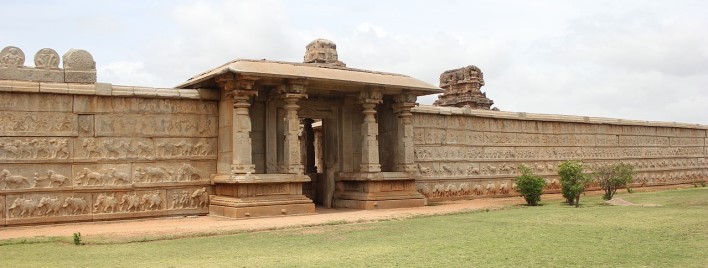
From: APRIL 20, 2017 BY MADUR: Karnataka.com
5. Relics of Ramayana
Hampi is also famous for the Hazara Ram temple. The temple has gained popularity because of the presence of historical objects and fossils that are claimed to be present at the time of Ram and Krishna’s era. The entire outer walls of the temple are carved and ornamented with the antique objects that narrate the Ramayana, a holy book that delineate the life of Lord Rama. It is claimed that the fossils and antique objects that are present in this temple are the rarest ones found in whole India. We bet did not know this fact about Hampi.
6. Naughty baby elephant
On entering the second tower on the left side in the Virupaksha Temple; one would see the temple’s main detainee, a baby elephant. If given a one-rupee coin, the elephant will collect it with his trunk and will kiss on the head as a blessing.
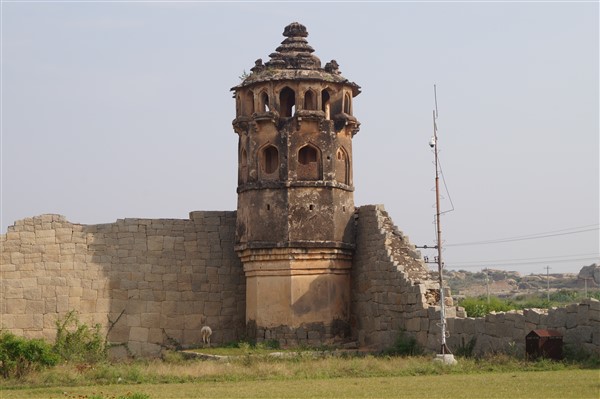
From: APRIL 20, 2017 BY MADUR: Karnataka.com
7. The inverted tower
There is a staircase behind the leading sanctum of the temple that heads towards the back exit of the temple. A dark chamber with a small opening in the wall is present before the exit on the right side. At the point when the sun beams go through the opening and fall on the western wall, the inverted main tower is visible as the shadow in the image.
8. Foodie Ganesha statue
There was a day when Ganesha’s stomach was about to explode since he stuffed a lot of his favorite meal. Tying his stomach with a snake was the last resort that Ganesha could find. As necessary, Ganesha tied a snake along his belly to escape the bursting of his stomach. This traces back the cause behind the unique design of the Ganesha’s statue in the temple. The Ganesha has 4 hands holding the pasha (noose), goad, his broken tusk and modak (sweet). This statue is made out of a single rock and is around 8 feet tall. The statue is covered with an old pavilion. Indeed, this is a less known fact about Hampi.
9. The royal enclosure
There exists an enclosure zone, where the royal group of the Vijayanagara Empire used to reside. This royal enclosure is spread over a range of 59,000 square meters. This enclosure can house around 43 houses at once. They royal families of the era used this place. The highlight of this place is the Lotus Mahal amidst the enclosure. This secluded are was built for queens and other royal ladies of the Vijayanagara Empire. Most of the parts of the enclosure are destroyed; even then the vestiges provide a great visual of the royal life of those times.

From: APRIL 20, 2017 BY MADUR: Karnataka.com
10. A long street – Hampi Bazaar
In front of the Virupaksha Temple unfolds a one-kilometre long street called the Hampi bazaar. The street is covered on both the sides with a set of old pavilions. The street makes a good place for a morning stroll with beautiful views on either side. A wooden car attired with tin sheets is in the midst of the street. During annual car festival, the tradition of pulling the car is practiced. There is a Nandi statue at the eastern end of the street, next to which lies the two storied photo gallery pavilion.
[edit] The temple town
Hampi, a temple town in northern Karnataka, was once the capital of the historical Vijayanagara Dynasty. This quaint place, lying amidst striking ruins of the past, has been receiving tourists from far off for ages. The magnificence of the ruins of temples and other structures of Vijayanagar, dating back to 1500 AD, is the main attraction of this place. According to some accounts, Hampi used to be the second largest city of the world.
Stone Chariot, Hampi There are innumerable boulders around Hampi that are easy to climb. One can get a stunning view of the ruins spread around Hampi by mounting one of the boulders. Located on the bank of the Tungabhadra River, Hampi has quite a number of tourist attractions like Virupaksha Temple, Vithala Temple and Nandi Statue. It is best to visit Hampi during the three day long Hampi festival held around October-November every year. Read more about Hampi
[edit] Yantrodharaka Hanuman Temple, Hampi – The Abode of Lord Hanuman
June 30, 2018 by madur, Karnataka.com
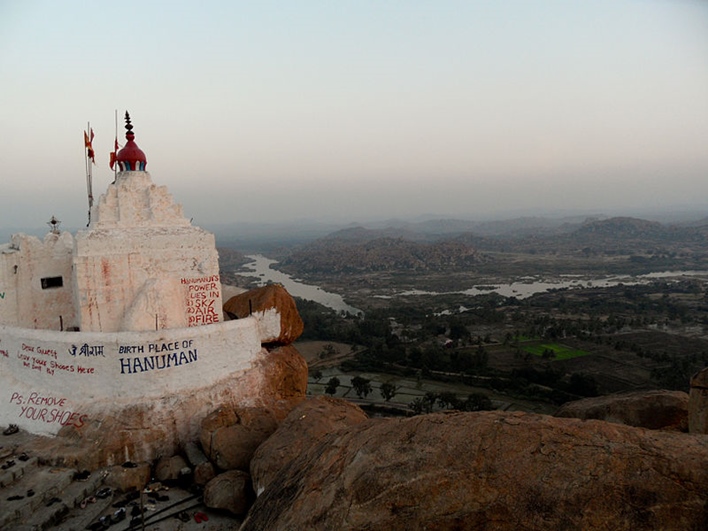
From: June 30, 2018 by madur, Karnataka.com
Dedicated to Lord Hanuman, the Yantrodharaka Hanuman Temple gets its name from the image of Hanuman placed inside an amulet. The position of Hanuman is different from any other image of Lord Hanuman that can be found in Hampi. This temple is the second most important shrine dedicated to Lord Hanuman in Hampi.
Yantrodharaka Hanuman Temple Yantrodharaka Hanuman Temple. Image courtesy Daniel Hauptstein
Quick Facts Yantrodharaka Hanuman Temple
Main Deity: Lord Hanuman
Best time to Visit: October to March
Temple Timings: Morning and evening
Entry Fee: Free
History of the Yantrodharaka Hanuman Temple
According to some legends, this temple is built on the place where Hanuman and Lord Ram met for the first time. Others believe that Sri Vyasaraja used to pray to Lord Hanuman in this place by drawing an image of Lord Hanuman on the rocks.
By the time he finished his prayers, the picture would have disappeared. When this happened for 12 days in a row, he pleaded with Lord Hanuman to appear before him. When the Lord appeared, he asked Sri Vyasaraja to constrain him in a six-sided amulet and build a temple in the area.
The Temple Architecture
The Anjaneya Temple is located on a hill on the banks of the Tungabhadra River. The inner sanctum contains an image of Lord Hanuman enclosed within a hexagonal amulet. Hanuman has been pictured in a meditative state. This is a marked deviation from other depictions of Lord Hanuman.
In Hampi, most depictions of Lord Hanuman show him standing with one hand raised and the other on his hip. It is only in this temple that Hanuman appears in a prayer position. In this image, Lord Hanuman’s crown has been formed by his tail.
12 monkeys have been carved around this amulet. They represent the 12 days Sri Vyasaraja prayed to Lord Hanuman. Each monkey holds the tail of the monkey in front of him but is facing backward. Seed syllables have also been carved around the amulet.
Other Things to See
Within the temple is another small temple devoted to Lord Ram. This lends credibility to the legend of Hanuman having met Lord Ram at this place.
Just ahead of the temple is a fig tree. At the foot of this tree are a number of snake-stones which are sued as places of snake worship.
A short climb ahead of the Temple is another small temple dedicated to an incarnation of Lord Vishnu.
[edit] The Jewel of Hampi- The Stone Chariot
The Jewel of Hampi- The Stone Chariot, July 9, 2017 by madur: Karnataka.com
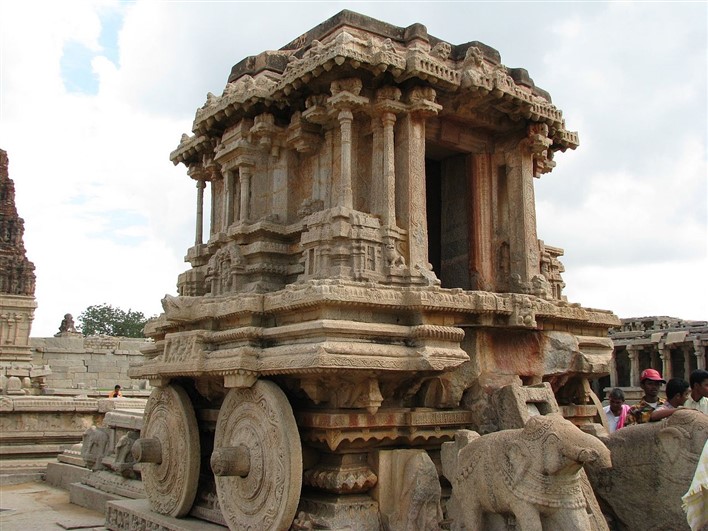
From: The Jewel of Hampi- The Stone Chariot, July 9, 2017 by madur: Karnataka.com
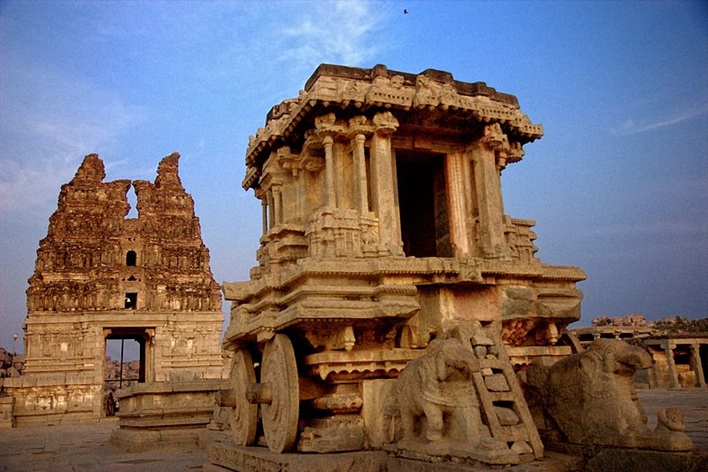
From: The Jewel of Hampi- The Stone Chariot, July 9, 2017 by madur: Karnataka.com

From: The Jewel of Hampi- The Stone Chariot, July 9, 2017 by madur: Karnataka.com
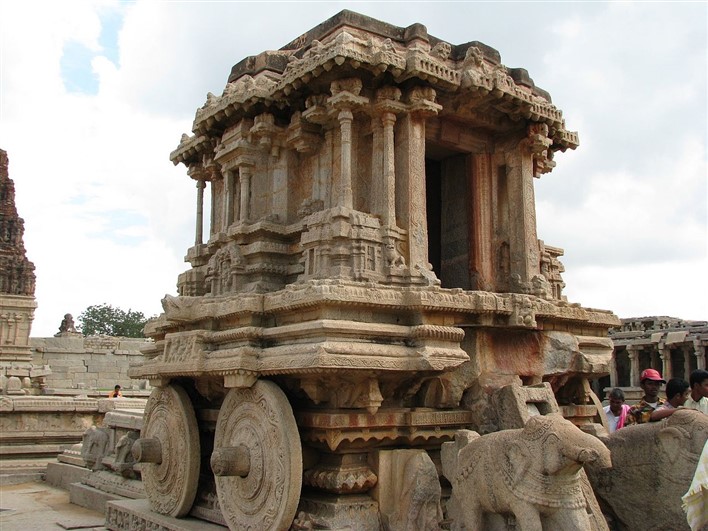
From: The Jewel of Hampi- The Stone Chariot, July 9, 2017 by madur: Karnataka.com
Every tourist place has that one spot which earns it galore and admiration. For Hampi, the small, dainty temple village set in Karnataka, it’s the iconic stone chariot. It’s the leading man in the army of exquisite beautiful sights that Hampi has to offer and depicts Karnataka tourism an icon itself.
The chariot is actually a shrine dedicated to Garuda, built inside the Vittala Temple Complex. The massive sculpture of Garuda, Lord Vishnu’s escort once was seated atop the chariot but it is empty at the present date. The Hampi Chariot has earned its name among the other three famous stone chariots in India- One in Konark, Odissa, and the other in Mahabalipuram (Tamil Nadu).
Quick Facts about the Stone Chariot
Timing: 8:30 AM to 5:00 PM on all days of the week
Entry Fee: No entry fee required
Photography: Allowed
Video camera: Allowed
Visit Duration: About 3 hours
Best time to visit: From November to February
History of the Chariot
The chariot was built by King Krishnadevaraya of the Vijayanagara Empire during the 16th century, who got fascinated with the Konark Sun temple chariot while fighting a battle in Odissa. The chariot is meant to represent the beauty and artistic perfection of the Empire. An interesting folklore emanates from the Hampi chariot as villagers believe that the world would come to a halt when the chariot moves from its place. It has come to have a sacrosanct presence and is internationally recognized as a world heritage site even by the UNESCO.
Architecture
Inspired by the Dravidian style of architecture, the chariot is a colossal structure which shows the skill of the earlier craftsmen and architects. The beauty of the chariot lies in the fact that it looks like one solid structure but in fact, has been built by slabs of granite whose linkages have been cleverly hidden with artistic designs.
The base on which the chariot rests depicts beautiful mythical battle scenes in intricate details. There were sculptures of horses where presently elephants are seated. Visitors can actually spot the hind legs and tails of the horses behind the elephants. There are also the remnants of the ladder in between the two elephants, using which priests used to climb up to the inner sanctum to pay homage to the sculpture of Garuda.
A beautiful illumination of the chariot happens in the evening from the floodlights installed in the Vittala Complex. The spectacular view of the chariot and its detailed designing in the glow of the lights from the complex makes for a mesmerizing experience.
Things to Know for Tourists
The Vittala Temple Complex is open on all days of the week from 8:30 AM to 5:00 PM.
There is no entry fee
The authorities allow for photography and videography within the temple complex.
Tourists normally spend about 3 hours at the complex.
[edit] Royal Enclosure – Home of Erstwhile Kings and Queens
JUNE 21, 2017 BY MADUR: Karnataka.com
The stone chariot of the Vittala Temple and the temple’s musical pillars may be the most recognizable architectural structure in Hampi but they are far from being the only ones. On the banks of the River Tungabhadra, Hampi is home to a number of Jain and Hindu temples, aqueducts and the Royal Enclosure spread over 59000 square meters. This was once upon a time, the home of the Vijayanagara King and his Queens. Today the enclosure lies largely in ruins but still speaks loudly of the life it once contained.
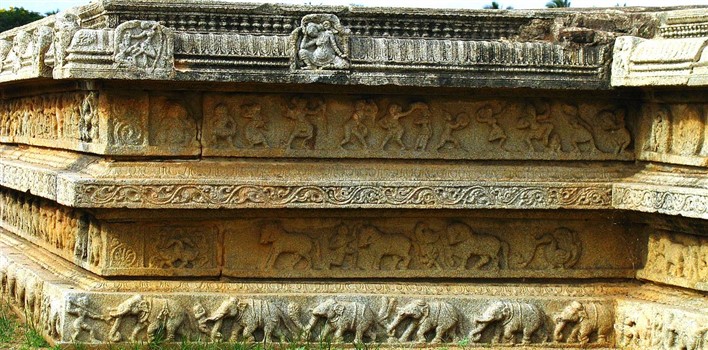
From: JUNE 21, 2017 BY MADUR: Karnataka.com
The Story of Hampi
Hampi rose into prominence in the early 14th century when the Kampili Kings rose in power. In 1327, the kingdom was attacked by Muhammad-bin-Tughluq who took two brothers, Bukka and Harihara as prisoners along with thousands of other people. These brothers tricked the Sultan into setting them free and returned to Kampili to set up a kingdom of their own with its capital at Vijayanagara. Thus the Vijayanagara Empire was founded by Harihara I and Bukka I of the Sungama dynasty in 1336. The Sungama dynasty was followed by the Saluvas and the Tuluvas each of whom added to this Vijayanagara’s architectural beauty. A number of prominent temples and architectural features of Hampi were built under the patronage of King Krishnadevaraya in the early 16th century. After his death, the Vijayanagara kingdom began its decline and the city was rediscovered only in the 1800s as Hampi.
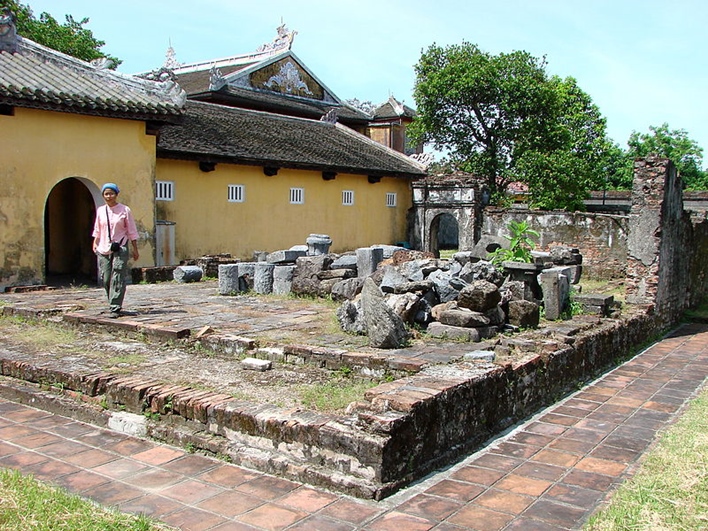
From: JUNE 21, 2017 BY MADUR: Karnataka.com
The Royal Enclosure and its Architecture
The royal enclosure in Hampi was the Vijayanagara kingdom’s seat of power. In its prime, it housed as many as 45 buildings including the durbar halls, platform, tanks, underground chambers, and temples. There are three entrances to the Royal Enclosure; two in the north and one in the west.
The architectural style of this enclosure is symbolic of the Vijayanagara style of architecture with traces of Mughal influence. As with all the other features constructed by the Vijayanagara kings, the Royal Enclosure makes ample use of granite and soapstone. All the palaces face the east or the north and were built on raised granite platforms. These platforms feature multiple tiers and are decorated with carved details of flowers, geese, demon faces, elephants and human figures. Though the palaces themselves may not stand today, ask recovered from the site suggests that they used wooden beams and rafters. Domed structures were built with a stone rubble and mortar mixture. The watch towers, elephant stables, and Lotus Mahal are examples of the Islamic influence to this style of architecture.
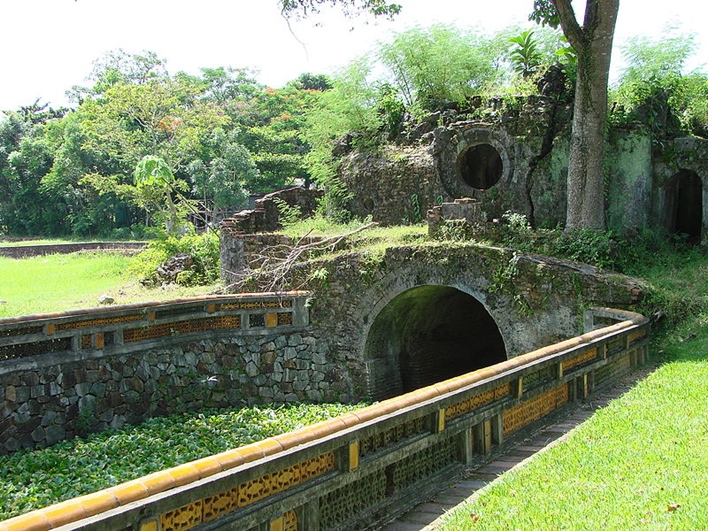
From: JUNE 21, 2017 BY MADUR: Karnataka.com
Things You Shouldn’t Miss
The Royal Enclosure of Hampi has often been compared to an open air museum. Apart from giving the visitor a glimpse into what life was like under the Vijayanagara rulers, it also showcases the architectural excellence of the era and the level of destruction the city witnessed after the decline of the Vijayanagara kings. Some of the most impressive structures here are:
The Mahanavami Dibba
This 3 tiered 8 meter high platform is the only structure that still stands as it did centuries ago. It stands in the northeast section of the enclosure and has a flight of stairs leading up on the east, west and southern face. Each tier of the platform features intricately sculpted moldings that depict the everyday life of that time. As the name suggests, the platform was used during the Navami celebrations and remains of pillar bases indicate that a pavilion once stood in the center.
The Aqueduct
Within the royal enclosure the aqueduct networks of stone ‘pipes’ connect over 20 wells and ponds. A large section of the aqueduct has been restored and some sections deliver water even today. Bukka’s Aqueduct towards the north of the river is the most significant amongst them.
Stepped Tank
Discovered in 1985, the stepped tank is considered one of the most well-preserved structures in the Royal Enclosure. This is a 5 tiered tank that covers an area of 22 square meters and has a depth of 7 meters. Two other significant bathing pavilions in the Royal Enclosure are the Octagonal Bath and the Queen’s bath.

From: JUNE 21, 2017 BY MADUR: Karnataka.com
Hazara Rama Temple
This is the only temple in the Royal Enclosure. As the name suggests, the temple is dedicated to Lord Rama. Bas relics on the walls of the temple depict the Ramayana and are considered the most extensive relics from all over India.
The Underground Chamber
This chamber lies between the Durbar Hall and the Stepped Tank ad features independent entry and exit routes. It is believed that the Vijayanagara rulers held important discussions with their trusted aides in this chamber.
Durbar Hall
This is also known as the King’s audience hall or the 100 pillared halls. Remnants of a stone staircase suggest that this might have been a two storied structure. It is believed to have been made of wood and destroyed in a fire in 1565 AD.
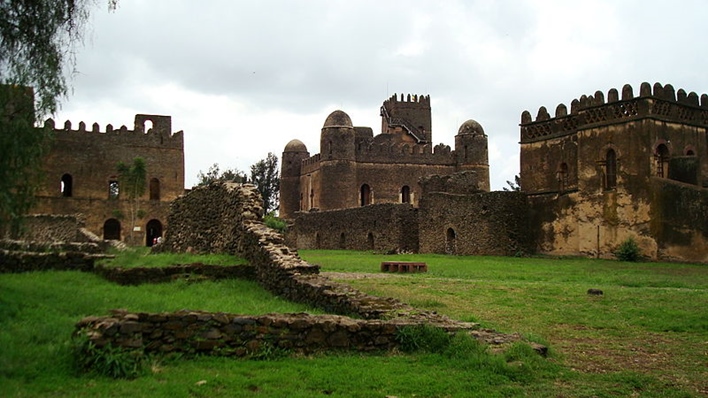
From: JUNE 21, 2017 BY MADUR: Karnataka.com
Present Condition of the Royal Enclosure
Today, only the stone platforms remain to mark where palaces and building once stood. Since many structures were made of wood, this area seems to have been easier to destroy than other parts of Hampi with complete stone structures. Though it may look like an empty area at first glance, a closer look will bring out many interesting relics and details.
[edit] Lotus Mahal in Hampi – Of Grandeur and History
APRIL 25, 2017 BY MADUR: Karnataka.com
A tour to Hampi is incomplete without visiting Lotus Mahal. It is one of the fine architectural designed palaces that are uniquely identified by its lotus look like structure. This glorious building is within the Zenana Enclosure, a segregated area that is used by the royal women of Vijayanagara Dynasty.
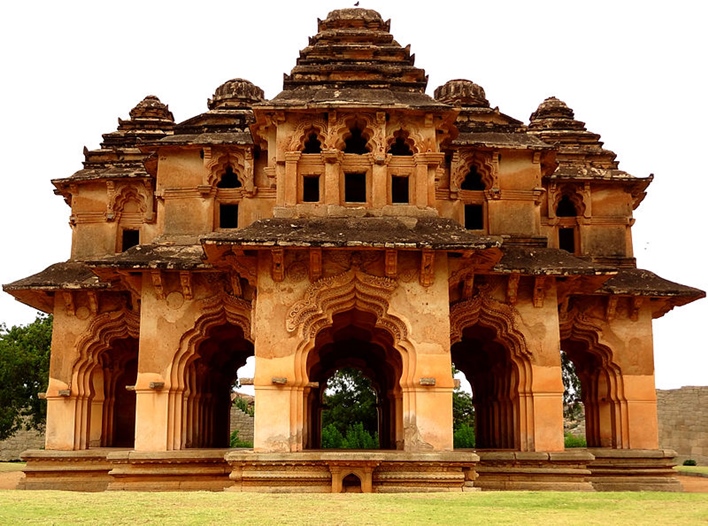
From: APRIL 25, 2017 BY MADUR: Karnataka.com
The Lotus Mahal is otherwise called the Kamal Mahal or Chitragani Mahal. It’s remarkable and unmistakable design is the main highlight of the palace. It is one of only a handful few astonishing building in Hampi that had not been damaged or destroyed amid the attack on the city.
Quick Facts about Lotus Mahal
Timing: Open on all days of the week from 8:00 am to 6:00 pm
Entry fee for adults: INR. 10 for Indians and INR 250 for foreign tourists
Entry fee for children: Entry is free for children under 15 years
Photography: Allowed (no extra charges levied)
Visit duration: 2 hours approximately
Best time to visit: From November to February
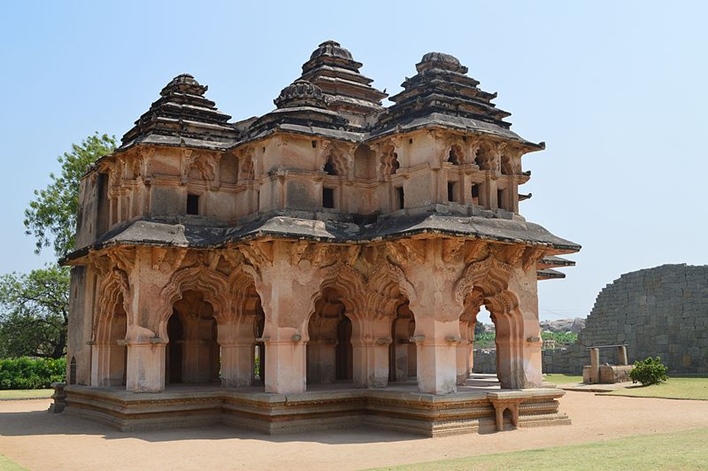
From: APRIL 25, 2017 BY MADUR: Karnataka.com
Architecture of the Lotus Mahal, Hampi
As the name given to the palace is because of the shape it resembles. The balcony and the passages covered with a dome that looks like an opened lotus bud. The central dome is also carved as a lotus bud. The curves of the palace are given an Islamic touch while the multi-layered roof design is moreover related to Indo style of buildings. The style and designs is an inquisitive blend of Islamic and Indian way of architecture.
The palace is a two-storied building, well-structured symmetrically. It is surrounded by a rectangular wall and four towers. These towers are also in pyramidal shape giving a lotus-like structure visual. Around 24 pillars are present to support the arched windows and balcony of the palace. The walls and pillars are carved beautifully with patterns like sea creatures and birds.
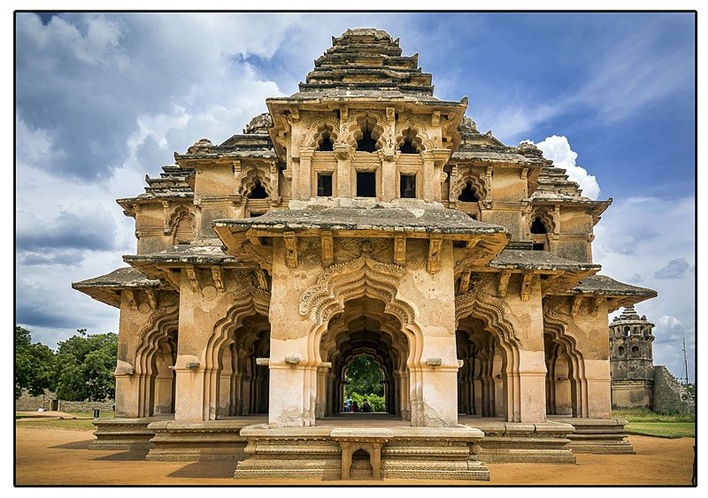
From: APRIL 25, 2017 BY MADUR: Karnataka.com
The surrounding area of the palace is covered with many shady trees providing a cool ambiance to the palace. At the point when the Lotus Mahal is lit up during the evening, visitors witness a fantastic view. It is a standout venue in entire Hampi to take photographs. Lotus Mahal should be a sure set destination in the list while visiting Hampi. It will stun you to perceive how best in class, Indian architecture and workers were ages back.
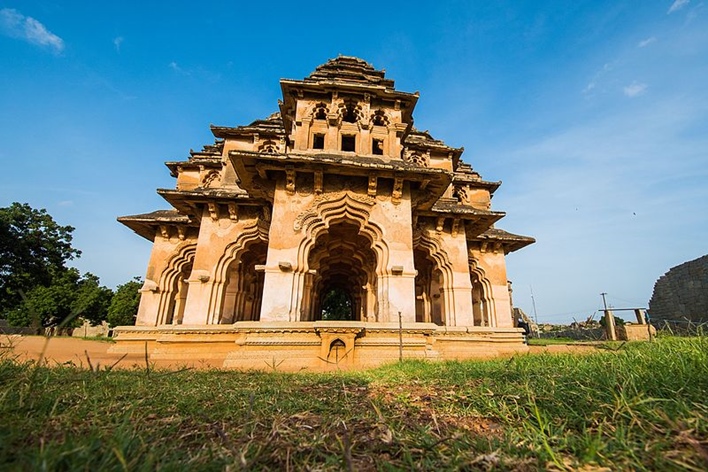
From: APRIL 25, 2017 BY MADUR: Karnataka.com
History of Lotus Mahal, Hampi
The Lotus Mahal was a part of Zenana enclosure, a place where royal families of Vijayanagara Empire resided. Lotus Mahal designed as a palace for royal ladies of those times to mingle around and enjoy recreational activities. The Mahal also served as a meeting point for the king and his ministers. This place is also referred to as a council chamber in the maps found.
It is said that the Queen of Krishna Deva Raya used to spend her most of the time seeking pleasure and peace in the palace. The palace also served as a meeting point for the king and his ministers. Kaml Mahl is also referred to as a council chamber in the maps found in 18th century. Kamal Mahal and Chitrangini Mahal are the other names by which it was known earlier. Several musical concerts and other recreation activities were held at this place.
[edit] Sasivekalu Ganesha Temple in Hampi
APRIL 24, 2017 BY MADUR: Karnataka.com
Hampi, a UNESCO world heritage site, is known for its magnificent temples and one such fine specimen is Sasivekalu Ganesha temple. Sasivekalu Ganesha Temple is a huge statue of Lord Ganesha, carved out of a single block of rock. It is one of the major landmarks in Hampi. Sasivekalu Ganesha is about 8 feet (2.5 metres) tall.

From: APRIL 24, 2017 BY MADUR: Karnataka.com
History of Sasivekalu Ganesha Temple
According to the Hindu mythology, Lord Ganesha is known for his love for food. Once Ganesha consumed a lot of food, due to which his stomach was on the verge of bursting. Finding no other option to stop his stomach from exploding, Ganesha caught hold of a snake and tied it around his stomach in order to prevent it from bursting open. This is the mythological incidence behind the existence of the snake tied around the Ganesha’s stomach, which is visible on the statue.
The inscription on the statue is as old as 1500 AD and says that this statue was erected in memory of the king Narasimha II, of the Vijayanagar Empire. This temple and the statue is indeed one of the finest specimens of Indian sculptures.
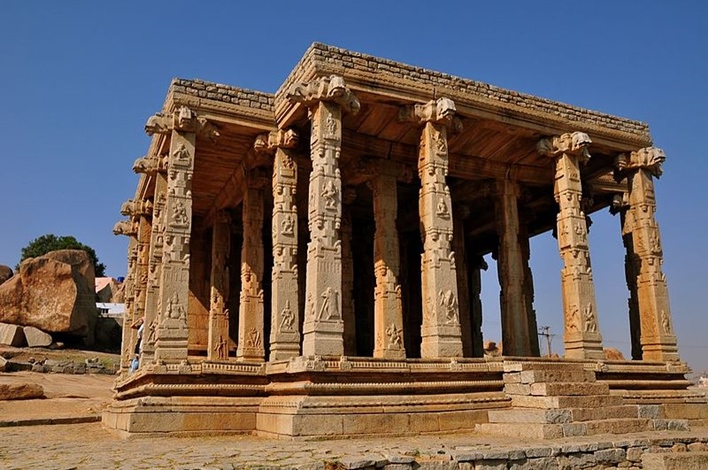
From: APRIL 24, 2017 BY MADUR: Karnataka.com
Architecture of Sasivekalu Ganesha Temple
The Ganesha is seen in a half-lotus position with four arms. The right and left hand at the upper side holds a goad and a broken tusk. The top right hand of the statue holds a sweet (modak) the left hand is portrayed with a noose. A large mandapa is covering the statue at the top with a rough wall covering pillars around it. The archaeology department has installed a huge sitemap consisting of whereabouts of the place and history of the statue.
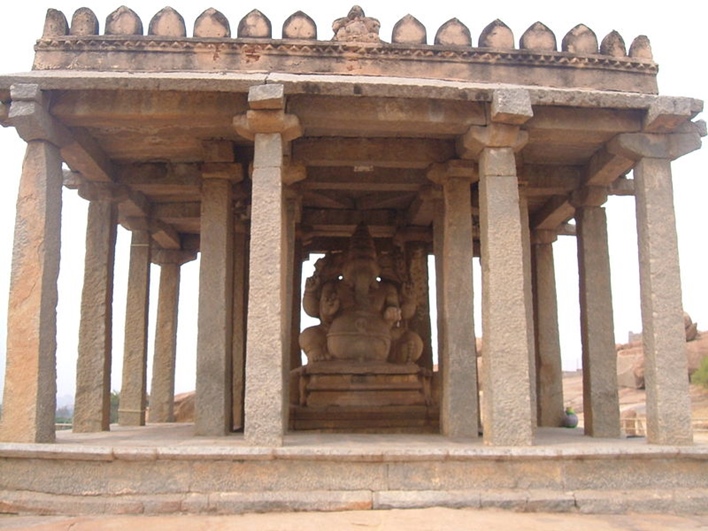
From: APRIL 24, 2017 BY MADUR: Karnataka.com
[edit] Achyuta Raya Temple, Hampi
APRIL 24, 2017 BY MADUR: Karnataka.com
The Achyuta Raya Temple is in Hampi. It was built in 1534 AD. It is one of the major, splendid and awe-inspiring temples of Hampi located between the Matanga hills and Gandhamadana. This magnificent temple depicts Vijayanagara architecture style of temples in its best and most improved form. This was among the last dazzling temples that were constructed in the celebrated city of Hampi prior to the decline of the Vijayanagara Empire.

From: APRIL 24, 2017 BY MADUR: Karnataka.com
Quick Facts About Achyuta Raya Temple, Hampi
Timing: From 5:30 AM – 1:00 PM and from 5:30 PM – 9:00 PM on all days of the week
Entry Fee: No entry fee required
Photography: Allowed
Visit Duration: About 2 hours
Unfortunately, this elegant and striking temple is in ruins as a consequence of the attacks by the monarchs of the Bahamani kingdom. It is greatly affected by the forces of nature over several centuries.
The location of the temple is secluded and off the more travelled path, the temple is much less crowded as compared to many other tourist attractions in Hampi. It is good news for the people who like quite tours because this place is off location and its hidden nature makes it less crowded. The best time to visit the temple is from November to February.
The main idol worshiped in the Achyuta Raya Temple is Lord Tiruvengalanatha which is another form of Vishnu.
The towers, pillars, and walls have exquisite carvings and ornamentation. Major parts of the temple are in a damaged condition. Although it is in ruins, the temple does not fail in grandiosity and its magnificence even today.
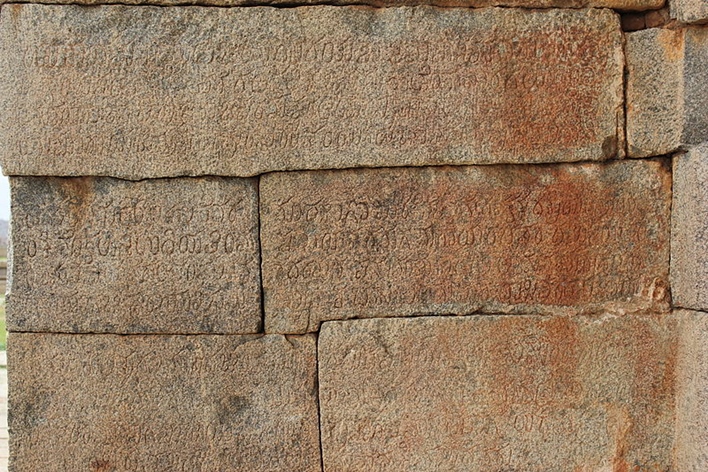
From: APRIL 24, 2017 BY MADUR: Karnataka.com
History of Achyuta Raya Temple, Hampi
The Achyuta Raya temple got built during the rule of Achyuta Deva Raya, who was one of the emperors of the Vijayanagara Empire. He came to power by succeeding his elder brother Krishna Deva Raya in the year 1529.
The stunning and heavenly temple is devoted to Lord Tiruvengalanatha; he is a configuration of Lord Vishnu. Thus, this temple was initially known as Tiruvengalanatha Temple. However, later on, it came to be called after the king in whose reign it was built. Hence, it became widely known as the Achyuta Raya temple.
Architecture of Achyuta Raya Temple
The principal shrine of the temple is located in the centre of a pair of rectangular concentric enclosures. There are pillared verandas on the interior flanks of the two courtyard walls. The outer walkways are in a state of decay, collapse, and disintegration. The temple is distinctly visible from the top of the Matanga Hill. It is at the end of the abandoned Courtesan Street.
On entering the inner court one can spot a chamber that is facing the porch leading to the central hall. There is a small shrine chamber which once sanctified an image of Garuda.
The accessible hall has few extremely lauded sculpted pillars in Hampi. The carvings are done on monolithic blocks of rocks. The statues and sculptures on the pillars reveal themes like lord Vishnu blessing an elephant, lord Krishna practising his flute while the calves are watching this scene with interest and infant Krishna dancing with a snake and holding it by the tail.
There is a Mandapa which is a marriage hall of the Gods and the Goddesses for the yearly nuptials.
[edit] Dasara Dibba – A Wonderful Stone Platform
PRIL 24, 2017 BY MADUR: Karnataka.com
Dasara Dibba or the Mahanavami Dibba is a beautiful stone platform located within the Royal Enclosure of Hampi. It was built during the Vijayanagara period by King Krishnadevaraya to commemorate his victory over Udaygiri. It was here where the King of Vijayanagar used to celebrate the festival of Dasara (Dussehra).
However, The Dasara Dibba is in a ruined state now with damaged carvings on the side of the platform. UNESCO and the Government have taken proper steps in preserving the heritage for future generations.
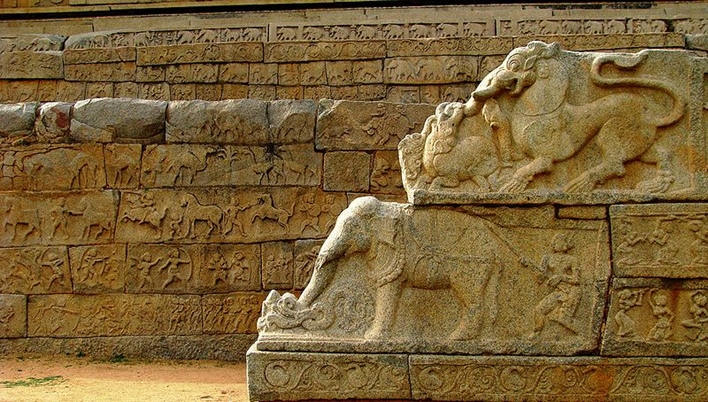
From: PRIL 24, 2017 BY MADUR: Karnataka.com
History and Legends
King Krishnadevaraya constructed this in 1513 AD in commemoration on the victory over Udaygiri (now in Orissa). According to historians, the Sagamas were the first ruling dynasty of the Vijayanagara kingdom in the 14th century.
However, Hampi reached its zenith of glory under Krishandeva Raya under whom, Hampi, the city of Victory came into full power. Hampi was destroyed in 1565 by the Deccan Sultanates.
The king watched the army march-pasts, bow and arrow competitions, war games such as sword fighting competition, wrestling, aquatic sports, musical performances of the royal animals and the hugely significant Navaratri celebrations from the raised structure of the grand platform of the Dasara Dibba.
Navaratri was celebrated for consecutive nine days according to the tradition and the tenth-day celebration was known as “Vijaya Dasami”.

From: PRIL 24, 2017 BY MADUR: Karnataka.com
Dasara Dibba – Architecture and Sculpture
The 12 meters high Dasara Dibba consist of a massive square granite faced base in three diminishing tiers, the lowest being 40 metre square and the topmost 24 metre square. The structure faces north. The stone stairs are little tough for climbing for elderly persons and kids as it is quite high to ascend.
The top can be reached by a couple of cases having carvings of elephants, horses, and others on the front while the back portion has twin staircase. This unique monument is one of the highest spots within this zone. The entry point for King to this point is different from that of the commoners. The walls are covered with auspicious carvings of horses, elephants, warriors, caravans, hunting games scenes, dancers, musicians and many other royal cultural scenes of the by-gone culture.
On the east side of the platform, is a chamber filled with animal and clown carvings narrating the stories of when the Chinese embassy used to visit the King Krishnadevaraya for business purpose and the Arab emirates came for horses and exotic animals trading.

From: PRIL 24, 2017 BY MADUR: Karnataka.com
The entry point for King to this point is different from that of the commoners. The walls are covered with auspicious carvings of horses, elephants, warriors, caravans, hunting games scenes, dancers, musicians and many other royal cultural scenes of the by-gone culture.
On the east side of the platform, is a chamber filled with animal and clown carvings narrating the stories of when the Chinese embassy used to visit the King Krishnadevaraya for business purpose and the Arab emirates came for horses and exotic animals trading.
On the east side of the platform, is a chamber filled with animal and clown carvings narrating the stories of when the Chinese embassy used to visit the King Krishnadevaraya for business purpose and the Arab emirates came for horses and exotic animals trading.
Entry to the Dasara Dibba is free and can be visited any time from sunrise to sunset, preferably during mornings or evenings as there is no shade.
[edit] Virupaksha Temple: Of History
APRIL 22, 2017 BY RAGGI MUDDE: Karnataka.com
The Virupaksha Temple in Hampi is dedicated to lord Shiva. The distance from Bangalore to Hampi is about 350 km. Hampi is a temple town in South India and is acknowledged as one of the World Heritage Sites of UNESCO. Virupaksha Temple is dedicated to lord Shiva. This temple was constructed in Lakkana Dandesha’s assistance who was a commander under King Deva Raya II.
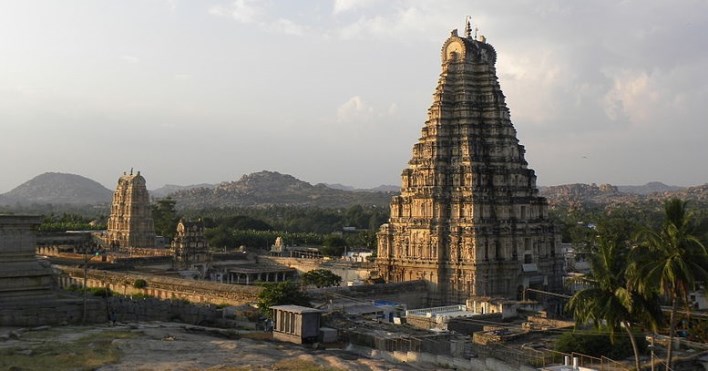
From: APRIL 22, 2017 BY RAGGI MUDDE: Karnataka.com
Hampi is on the embankment of River Tungabhadra. The predominant centre of pilgrimage in Hampi is this esteemed temple. It is the holiest and sacred retreat.
The Virupaksha temple has survived through the years and never ceases to prosper. It is still pristine amidst the ruins that surround it. It attracts large groups of people in the month of December. The yearly chariot festival is conducted in the month of February.
History of Virupaksha Temple
The Virupaksha temple’s chronicle is unremitting from around the seventh century. Virupaksha-Pampa retreat was existent since a long time here. There are several inscriptions about Lord Shiva which were engraved in the 9th century.
It started off as a little shrine and later developed into a huge complex during the Vijayanagara rule. There is evidence that indicates additions were made to Virupaksha temple during the later years of the Hoysala and Chalukyan sovereignty.
Native art, craft, and culture flourished during the fourteenth century during the reign of the dynasty. But these beautiful architectures and creations were destroyed when the Vijayanagara rulers were crushed by Muslim intruders.
The devotional group of Pampa and Virupaksha did not come to an end with the devastation of Hampi in 1565. The temple is worshiped even today and has persisted all over the years. There were extensive renovations done in the early 19th century that include the addition of towers and ceiling paintings.
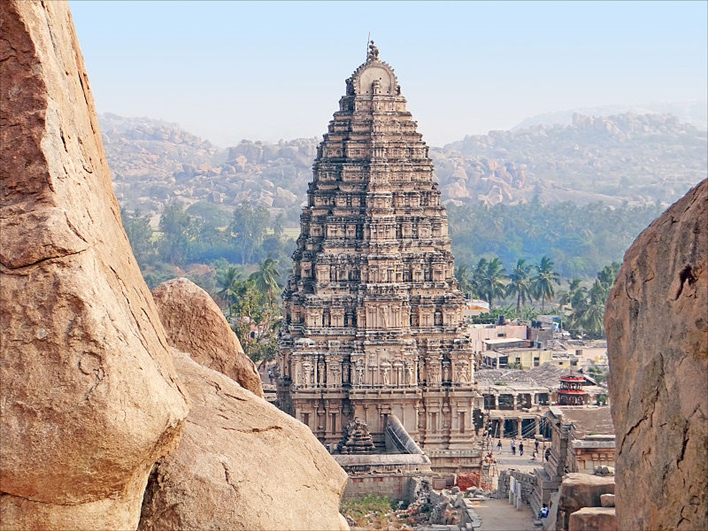
From: APRIL 22, 2017 BY RAGGI MUDDE: Karnataka.com
Virupaksha Temple Architecture
The temple has a shrine or the holy place of worship, a hall with a number of pillars and 3 antechambers. There are courtyards, a pillared monastery, few small shrines; and entrance ways surrounding the temple.
Among all the gateways, the eastern gateway is the greatest. It is nine-tiered and 50 meters in length. It is well built and has some previous structures. The framework is of brick and includes a gravel base giving way to the court outside. This court contains various sub-sanctums. The inner eastern gopuram is graced with three storeys while the northern gopuram has five storeys.
The Kanakagiri gopuram towards the north takes the tourists to a little enclosure with supplementary sanctums.
A renowned Vijayanagara King, Krishnadevaraya was a contributor of the temple. It is believed that the main pillared hall which is the most adorned structure of this temple is his addition. There is a stone slab beside the hall which has inscriptions that explain his offerings for the temple.
Surrounding the Virupaksha temple are plenty of dilapidated mandapams. There was an ancient shopping centre interlined with mandapams in front of this temple. The ruins of it stand today.

From: APRIL 22, 2017 BY RAGGI MUDDE: Karnataka.com
[edit] Saraswati Temple, Hampi: An Erstwhile Glory
APRIL 22, 2017 BY RAGGI MUDDE: Karnataka.com
The Saraswati Temple is situated in the district of Bellary in Hampi. Hampi is at the heart of the city Vijayanagara, which is in a dilapidated state. Hampi is a hugely renowned site, and it is registered as a World Heritage Site by the UNESCO.
The temple is mostly in ruins now but has its old world charm. The shrine, sanctum, canopy and the pavilions are better in condition than the rest of the structure. Beautiful sculptures are still found on the pillars. The crawling baby Krishna’s carving is seen on the tower of the temple. The temple is devoted to goddess Saraswati who is the goddess of intelligence, understanding, knowledge and wisdom.
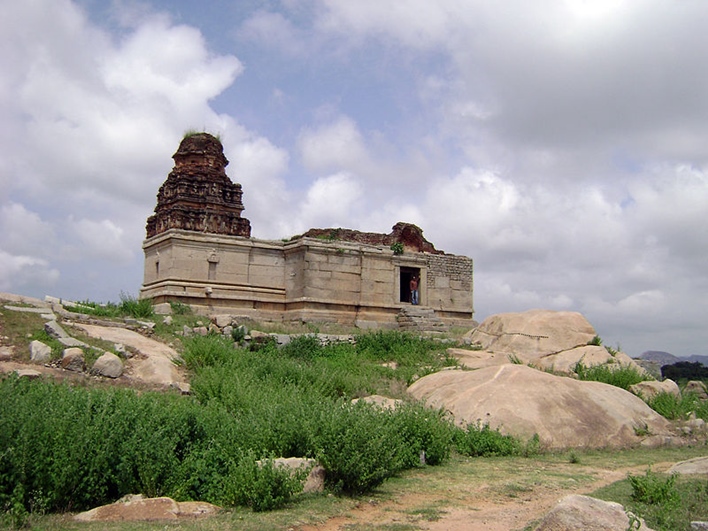
From: APRIL 22, 2017 BY RAGGI MUDDE: Karnataka.com
The Hampi ruins are sprawled in its nature and hence taking a map of the area is always beneficial. Carrying a map helps in better chalking out of the local itinerary. It is difficult to cover the entire sites of Hampi in a few days stay. There are detailed sitemaps that are displayed by the Archaeological Survey of India near the monuments in Hampi.
Saraswati Temple Architecture
This temple was built during the 13th century in Vijayanagar style and is located nearby an octagonal bath in the midst of the ruins. If the tourists are inquisitive enough then they might take a closer look at the pillars which expose plasterwork on their stone pillars with some remains of stucco images. The art and architecture of the temple can be well understood if the visitor can walk towards the path between the canal and the temple.
Goddess Saraswati is idolized and worshiped as the goddess of wisdom, knowledge and literary aspects in the Indian mythology. She has four hands, each of which holds different things. One hand has a book that represents the Vedas; one has prayer beads of pearl that signify spirituality; one holds a pot containing holy water and another one has a musical instrument Veena epitomizing fine art.
There is an enthralling rock near the temple having an image of the goddess carved on it. Around this rock, there is a shrine which is painted with beautiful bright colours. This gives an indication that the temple was built to honour the goddess. Glimpses of the history of Hampi can be known if a visitor travels to the Saraswati temple.

From: APRIL 22, 2017 BY RAGGI MUDDE: Karnataka.com
[edit] Gejjala Mantapa, Hampi – An Ornate Platform
APRIL 8, 2015 BY MADUR: Karnataka.com

From: APRIL 8, 2015 BY MADUR: Karnataka.com
The Gejjala Mantapa is an ancient structure in Hampi with a highly impressive architecture. It is located at a short distance from the famous Vittala Temple and stands near the Chariot Street. The Gejjala Mantapa is believed to have been used for religious functions during the days of the Vijayanagara Empire.
Gejjala Mantapa is one of the most ornately decorated structures found in the ruins of Hampi. The small but attractive structure draws the attention of tourists throughout the year.
Quick Facts
Timing: 7:00 AM – 7:00 PM on all days of the week
Entry Fee: No entry fee required
Photography: Allowed
Video Camera: Allowed
Visit Duration: About 30 min
Best time to visit: From November to February
History of Gejjala Mantapa, Hampi
The Gejjala Mantapa was constructed by one of the rulers of the Vijayanagara Empire. As such, the origin of the mantapa dates back to more than 500 years ago, when the Vijayanagara Kingdom flourished in South India.
The Gejjala Mantapa is a unique structure. There is no written document or inscription to suggest the exact purpose of the ornate structure. However, its proximity to the Vittala Temple and its beautifully carved pillars suggest that the structure may have been used to keep the statues and idols of Gods during the annual temple festival of Vijayanagara that was prevalent in that era.
Some people believe that the structure was used as a dancing hall in the ancient times. According to them, the Gejjala Mantapa was a platform where various music and dance festivals were conducted in the ancient times.
Architecture of Gejjala Mantapa, Hampi
The Gejjala Mantapa is a rectangular structure with an exceptional architecture. The intricate pattern of carvings that exist on the structure displays the beauty of the Vijayanagara style of architecture. The whole structure has been built from huge stones, as is the characteristic of almost every structure found in Hampi.
The structure has an elevated platform that is surrounded by an open pillared pavilion on all sides. The beautifully carved domed roof of Gejjala Mantapa features the typical Vijayanagara style brick work.
However, the main attraction of the structure is the two rows of pillars standing in concentric pattern around the elevated platform. Each pillar is a square shaped carved structure that is an architectural delight in itself.
The pillars are the backbone of the superstructure and provide the monument with a touch of classic beauty. Even the ceiling of the structure displays an elaborate look due to the beautiful carved designs present there.
Present Condition of Gejjala Mantapa, Hampi
The Gejjala Mantapa is located against the backdrop of coconut and banana trees. It offers an exceptional look to the surroundings of the structure.
The ornate structure has stood the test of time and weather for more than 500 years and is still in a good condition. It is one of the few lucky structures that have escaped destruction at the hands of the Mughal attackers who had completely ruined the Vijayanagara Empire.
Standing on a patch of greenery, this monument is a wonderful example of the craftsmanship of the artisans of that era.
[edit] Yeduru Basavanna, Hampi – An Ancient Sculpture
FEBRUARY 28, 2015 BY MADUR: Karnataka.com

From: FEBRUARY 28, 2015 BY MADUR: Karnataka.com
Yeduru Basavanna or Eduru Basavanna is a huge sculpture of a monolithic bull. It is located at the east end of the Virupaksha Bazaar in Hampi. The sculpture is known and admired for its astonishing size.
The simple sculpture has been standing in Hampi for more than 500 years now. It is one of the prominent sculptures in the ruined town of Hampi and is a huge attraction among the tourists.
Quick Facts
Timing: 7:00 AM – 8:00 PM on all days of the week
Entry Fee: No entry fee required
Photography: Allowed
Video Camera: Allowed
Visit Duration: About 20 to 30 minutes
Best time to visit: From November to February
History of Yeduru Basavanna, Hampi
The Yeduru Basavanna, also known as the monolithic bull of Hampi, dates back to the time of the Vijayanagara Empire. The impressive sculpture is believed to have been constructed by one of the rulers of the Vijayanagara kingdom during the peak of the Vijayanagara Empire.
The huge bull has been standing guard over Hampi for many centuries now. It has withstood the extensive destruction initiated by the Mughal attackers that led to the downfall of the Vijayanagara kingdom in 1565 A.D.
Throughout all the centuries it has stood solidly against the trials of weather and time. It is regarded as one of the most popular statues in Hampi.
Mythology Related to Yeduru Basavanna, Hampi
The monolithic bull of Hampi represents Nandi, the mount of Lord Shiva. Nandi is also considered to be the gatekeeper of Lord Shiva. As such, Nandi is a much revered entity among the Hindus. This belief has paved the way for the monolithic bull to be considered as a sacred or holy sculpture in Hampi.
As per local legend, Yeduru Basavanna was regarded as the guard and protector of Hampi during the ancient times.
Architecture of Yeduru Basavanna, Hampi
The giant bull or Nandi is an impressive sculpture. It has been carved out of a single gigantic boulder and has been chiselled in a simple manner. The impressive statue displays all its features of a bull prominently. Though it does not have the elaborate carvings found in most other sculptures of Hampi, it has a unique charm and attraction of its own. Interestingly, the statue of the bull faces the Virupaksha Temple that is situated at some distance from the statue. The Virupaksha Temple is dedicated to Lord Shiva.
The statue of the bull is placed in a sheltered and elevated platform that stands against the backdrop of huge boulders.
Present Condition of Yeduru Basavanna, Hampi
The monolith bull is among those few structures in Hampi that was not ruined during the attack on the Vijayanagara Kingdom by the Mughals in 1565 A.D. However, the structure could not escape the clutches of time and weather completely.
Today the structure is in a semi-ruined condition. Though crude in its form and appearance, the monolith bull is a huge draw for tourists who visit Hampi.
[edit] Zenana Enclosure, Hampi – Private Place for Royal Ladies
FEBRUARY 25, 2015 BY MADUR: Karnataka.com
The Zenana Enclosure was a fortified and secluded area reserved for the royal ladies of the Vijayanagara Empire. The Zenana Enclosure is located in the area approaching the Royal Enclosure and near the Ranga Temple.
The enclosure is a sprawling compound that had tall walls surrounding it on all sides and watch towers to keep guard against any trespassers. It was constructed during the days of the Vijayanagara Empire.
The highlight of the Zenana Enclosure is the Lotus Mahal or Kamal Mahal, one of the most remarkable structures in Hampi.
Quick Facts
Timing: 8:00 AM to 6:00 PM on all days of the week
Entry Fee for Indians: 10.00
Entry Fee for Foreigners: 250.00
Entry Fee for Children: Free for Children under 15 years of age
Photography: Allowed (no extra charges levied)
Video Charges: RS. 25.00
Visit Duration: Around 3 hours
Best time to visit: From November to February
Protection Provided to Zenana Enclosure, Hampi
A distinctive feature about the Zenana Enclosure is that it was a well-guarded place during the days of the Vijayanagara Empire. The fortified area has two entrances, one in the northern side and the other in the north-eastern side.
The enclosure initially had four watch towers. But now, there are just three watch towers which are located in the eastern, south eastern and northern sides of the enclosure. The presence of these three watch towers indicates that the enclosure was a protected area that offered privacy to the royal women of the Vijayanagara Empire, including the Queen.
It is believed that the watch towers and the whole enclosure were guarded by the eunuchs. These eunuchs prevented any male from entering the area. The only exception is believed to be the king, who had the right to visit his queen inside the enclosure.
Unique Architecture of Zenana Enclosure, Hampi
The structures of the Zenana Enclosure are designed in the Indo-Islamic style of architecture. It is a deviation from the traditional Vijayanagara style of architecture seen in most monuments and structures of Hampi. The design of the structures in the Indo-Islamic style reflects the secular view of the rulers of the Vijayanagara Empire.
Though most of the structures within the enclosure are in a ruined condition, the Lotus Mahal is in an undamaged condition. It provides ample scope for visitors to admire the exceptional and distinctive architecture used for the design of the structure.
Key Attractions of Zenana Enclosure, Hampi
The Zenana Enclosure is an area that has quite a few interesting structures. The fortified area includes several structures such as the Lotus Mahal, Basement of the Queen’s Palace, Water Pavilion, Treasury Building and the Watch Towers.
Lotus Mahal: The main attraction of the Zenana Enclosure is the Lotus Mahal. It is located in the south-eastern corner of the enclosure. It is one of the most famous structures in Hampi and one of the very few structures that have been left undamaged by the Mughal attackers. It is a beautiful domed structure has been designed in the shape of a lotus bud.
The archways of the structure resemble petals of a lotus and provide the whole structure the shape of a half-open lotus bud. The Lotus Mahal is a two storied symmetric structure that has tall arched windows.
Basement of Queen’s Palace: The Queen’s Palace is a ruined structure that has only the basement as a proof of its existence. The basement is located in the centre of the Zenana Enclosure. The basement has an area of about 46 x 29 meters. It is the largest palace base excavated among the Hampi ruins so far.
The elaborate base is a three-tiered ornate structure that suggests that the original palace might have been a grand structure. There is a deep rectangular water tank near the basement. It was probably used as a source of water for the palace.
Water Pavilion: The Water Pavilion is located opposite to the palace base and at the eastern side of the enclosure. The water pavilion is a decorated platform situated in the centre of a shallow pool. Though the water pavilion is no longer in a working condition, the low spot is one of the attractions of the enclosure.
Treasury Building: The Royal Treasury Building is a rectangular structure that is located in the north-western corner of the enclosure. The building is a plain looking structure, without any distinctive features. It has a simple entry at the eastern side.
The building has a corridor inside that runs on all sides and has arches at regular intervals. Some people believe that it was actually the quarters of the eunuchs who used to guard the Zenana Enclosure.
However, the building contains no windows or any source of light. This enhances the belief that it was not used as a living quarter, but as a storage space for something important.
Watch Towers: The three Watch Towers are located in three corners of the enclosure. Each tower is a two storied structure built in the Indo-Islamic style of architecture. There are steps that lead to the top of two of the towers.
The sight from the top is a beautiful one. Visitors can have a view of the surrounding areas and the Elephant Stables situated behind the enclosure from the top of the towers. It is believed that the ladies of the royal family could stand at the top of the these watch towers and look at the royal processions and other ceremonies without being seen by the common people.
Contrasting Belief about the Zenana Enclosure, Hampi

From: FEBRUARY 25, 2015 BY MADUR: Karnataka.com
Some archaeologists believe that the Zenana Enclosure was not at all an area for the Royal women. They assume that the Lotus Mahal was a council room where the King used to hold meetings with his chief commanders.
The treasury building is supposed to be an armoury. According to them, the palace was the King’s Palace. Their assumptions are based on the fact that the area of the Zenana Enclosure is located near the Elephant Stables and the Guards Quarters.
The area is considered to be more appropriate for being a King’s habitat rather than a secluded place for the royal women.
Present Condition of the Zenana Enclosure, Hampi
The Zenana Enclosure has some ruined buildings and a few undamaged structures. The surrounding wall of the enclosure is in a ruined state. The watch towers are in a ruined state, but at least one can be accessed to reach the top.
The water pavilion is also in a non-functional state. The treasury building is also in a state of ruins. The Queen’s Palace is a totally ruined structure with just the basement remaining there.
However, the one structure that is in an almost intact condition is the Lotus Mahal. It is not only the main attraction of the Zenana Enclosure, but also one of the most beautiful structures found among the ruins in Hampi.
[edit] Varaha Temple, Hampi – An Impressive Structure
FEBRUARY 22, 2015 BY MADUR : Karnataka.com
The Varaha Temple is one of the most impressive temples in Hampi. The structure is famous for its architectural beauty and carvings on the walls. The temple is located at the northern end of the Courtesans’ Street and is close to the riverside.
The Varaha Temple is dedicated to Varaha Swamy, one of the ten incarnations of Lord Vishnu. The temple is a protected structure under The Ancient Monuments and Archaeological Sites and Remains Act, 1958. It is a major draw for tourists who visit Hampi.
Quick Facts
Timing: 9:00 AM to 5:30 PM on all days of the week
Entry Fee: No entry fee required
Still Photography: Allowed
Video Camera: Allowed
Visit Duration: About 2 hours
Parking Fee: Parking is free
Best time to visit: From November to February
History of Varaha Temple, Hampi
The Varaha Temple was built in the 13th century, during the reign of the Vijayanagara Empire. It was a significant place of worship in that era. Vishnu is one of the most popular deities of the Hindus. As such, his incarnation Varaha was also much revered by the people of Hampi.
Legend Associated with Varaha Temple, Hampi
Legend has it that Varaha, the mythical boar, was the third incarnation of Lord Vishnu. According to Hindu mythology, the reason behind the Varaha incarnation of Lord Vishnu was to protect the earth from a demon named Hiranyaksha.
The demon had dragged the earth to the bottom of the mythic ocean. Vishnu appeared as Varaha and went inside the ocean to rescue the earth. A long battle took place between Hiranyaksha and Varaha.
It is believed that the battle lasted for about a thousand years. Finally Varaha emerged victorious and saved the earth from the demon’s hands.
He emerged out of the ocean by carrying the earth between his tusks. As such, he is also known as the eternal upholder of the earth.
Architecture of Varaha Temple, Hampi
The Varaha temple was built in the typical Vijayanagara style of architecture. The temple complex is a rectangular area bounded by a wall. A huge entrance tower adorns one side of the complex. Though damaged to a large extent, the entrance tower still reflects the beauty and grandeur that was once attached to it. The temple stands in the middle of the large compound.
An interesting fact to note is that the walls of the temple have images and bas-relics of boars carved into them. The remarkable thing about these carvings is that some of them represent the insignia of the Vijayanagara kings.
The Royal insignia of Vijayanagara comprises of 4 elements, namely, Varaha (the boar), Sun, Moon and Dagger. The presence of an image of the Royal insignia on the temple wall points towards the significance of the temple during the ancient times.
Dispute Regarding the Varaha Temple, Hampi
There is some dispute regarding the reigning deity of the Varaha Temple. According to a section of experts the temple is dedicated to Lord Shiva and not Lord Vishnu, as commonly believed. Their argument is that the artefacts found along the temple configuration point towards the basis of the theory regarding a Shiva temple.
There are a few local stories that revolve around the reigning deity of the temple, but none of them can be verified concretely. Like many other structures in Hampi, the truth regarding this temple has also sunk under the heaps of ruins.
Present condition of Varaha Temple, Hampi
The Varaha Temple is in partial ruins today. The top portion of the beautiful entrance gate is no longer there as it was damaged long ago. The sanctum sanctorum is an empty chamber as the idol is no longer there.
Most probably, the idol was damaged during the Mughal raids on Hampi that led to the fall of the Vijayanagara Empire. Even then, the temple has an old-world charm surrounding [ India Today].
The carvings on the wall are amazing sights. The bas-relics on the walls display the skill of the craftsmen who worked on the temple. The temple is managed under the Archaeological Survey of India.
Recently the Archaeological Survey of India has partially renovated the temple in its attempt to preserve this historical structure.
[edit] Uddana Veerabhadra Temple, Hampi – Shrine for a Cult Deity
FEBRUARY 18, 2015 BY MADUR: Karnataka.com
Uddana Veerabhadra temple is an ancient shrine in Hampi that is known for its religious significance. The temple has the largest statue of the demon king Veerabhadra, built during the Vijayanagara period, in Hampi.
The temple is located southeast to the Chandikesvara Temple and midway between the Sacred Centre and the Royal Enclosure. It stands just near the main road to Hampi. In fact the main road just passes between the temple compound and the tall monolithic lamp-post standing in front of it.
The whitewashed temple is not really a tourist attraction, but it is a prominent religious destination in Hampi. Uddana Veerabhadra temple is also known as Mudduviranna temple according to the inscription.
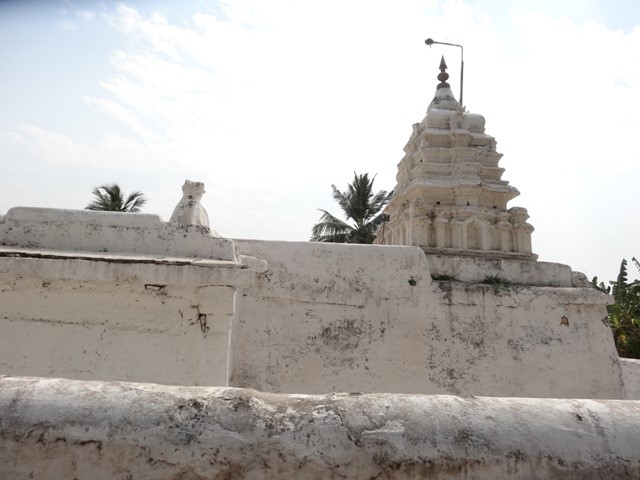
From: FEBRUARY 18, 2015 BY MADUR: Karnataka.com
Quick Facts
Timing: 9:00 AM to 5:30 PM on all days of the week
Entry Fee: No entry fee required
Still Photography: Not allowed inside the sanctum sanctorum
Video Camera: Strictly prohibited inside the sanctum sanctorum
Visit Duration: About 1 hour
Parking Fee: Parking is free
Best time to visit: Throughout the year
History of Uddana Veerabhadra Temple, Hampi
The Uddana Veerabhadra Temple dates back to the era of the Vijayanagara Empire. It was consecrated by Dalavayi Jangamayya in the year 1545 AD. The temple is dedicated to Veerabhadra, an incarnation of Lord Shiva. Veerabhadra is a cult deity who represents the ferocious form of Lord Shiva.
The presence of the Uddana Veerabhadra Temple in Hampi points towards the fact that during the Vijayanagara days the people of Hampi used to worship the Gods in their ferocious forms as well. In fact the ruins of Hampi provide plenty of evidences about the existence of this cult.
Veerabhadra is also called Muddu Veeranna in the local dialect. Hence, the temple is also known as Mudduviranna temple.
Legend Related to Uddana Veerabhadra Temple, Hampi
There is an interesting legend associated with the origin of the cult deity Veerabhadra. Legend has it that King Daksha had a beautiful daughter named Sati. She was an ardent devotee of Lord Shiva and married him against the wishes of her father.
Daksha did not approve of the marriage. Once Daksha held a special occasion and invited all the Gods and sages to the event except his daughter Sati and her husband Shiva. When Sati arrived at the event without invitation, Daksha insulted Sati and abused Shiva in front of Sati and all other guests. Sati was unable to bear the insults and abuses heaped on her husband. She committed suicide by jumping into the sacrificial fire at the venue.
On hearing the news about Sati’s death Shiva became enraged. He plucked out a lock of his matted hair and threw it on the ground with immense anger. Out of that lock of hair were born the demon god Veerabhadra and Goddess Kali.
Shiva’s anger led to unleashing of terror at Daksha’s palace and ultimately Daksha was beheaded.
Even the Gods of the heaven became afraid of Shiva’s fury and appealed to him for mercy. They requested Shiva to bring back Daksha to life. Shiva relented and replaced Daksha’s head with that of a goat and brought him back to life. After this incident, Daksha turned into a devotee of Shiva.
According to mythology, Veerabhadra is an incarnation of Lord Shiva himself and Kali is his consort. That is why a section of the people worships Veerabhadra as a form of Shiva.
Architecture of Uddana Veerabhadra Temple, Hampi
The Uddana Veerabhadra Temple is built in the Vijayanagara style of architecture. Though it is not as grand as some of the other famous temples of Hampi, it draws a large number of devotees due to its religious importance.
The temple complex comprises of a large garbhagriha, an antarala and a pillared mukhamantapa. The temple has simple doors painted in saffron colour. The main deity of the temple, Veerabhadra, is 16 feet high well sculpted image of Veerabhadra.
There is no other image of Veerabhadra in Hampi built during the Vijayanagara period that is larger than this image. This image of Veerabhadra has four hands. The upper hands bear bow and arrow and the lower hands bear sword and shield. The image depicts the warrior nature of the demon king.
A few unique things about Uddana Veerabhadra Temple, Hampi
There are a few unique facts to note about the Uddana Veerabhadra Temple. They are:
The temple has a small image of goat headed Daksha placed near the main image of Veerabhadra.
The temple has the unique Sarvanga Linga installed inside the sanctum sanctorum.
The priests who perform puja at this temple belong to the Lingayath community, which is a deviation from the tradition of the Brahmin community performing the puja rites everywhere.
[edit] Stone Trough, Hampi – Remnant of the Ancient Times
FEBRUARY 15, 2015 BY MADUR: Karnataka.com
The Stone Trough in Hampi is an ancient water trough that was used to provide drinking water to the horses during the days of the Vijayanagara Empire. It is located just outside the King’s Audience Hall whose remnants exist within the Royal Enclosure in Hampi.
The stone trough is a simple rock object that was an item of utility during the days when the Vijayanagara Empire was at its peak. The stone trough attracts the attention of the visitors due to its unusually long size and distinct shape.
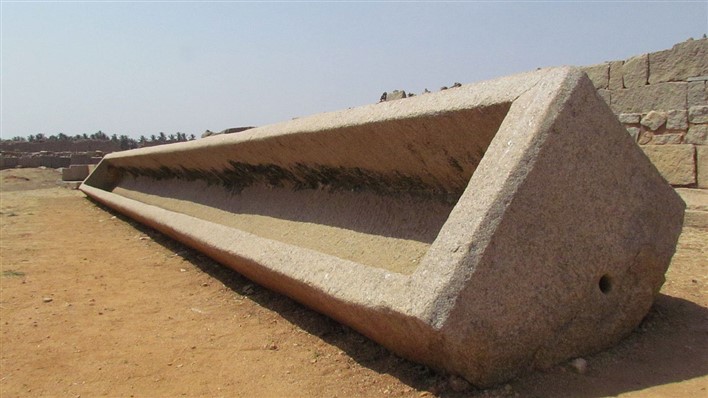
From: FEBRUARY 15, 2015 BY MADUR: Karnataka.com
Quick Facts
Timing: 8:00 AM – 6:00 PM on all days of the week
Entry Fee: No entry fee required
Photography: Allowed
Video Camera: Allowed
Visit Duration: About 20 to 30 minutes
Best time to visit: From November to February
History of the Stone Trough, Hampi
The Stone Trough is an object that dates back to the days of the Vijayanagara Empire. The utility item was constructed to provide relief to the thirsty horses while their masters attended to more pressing problems of the kingdom or solved other issues.
Its location outside the King’s Audience Hall indicates that it was used to provide drinking water to the horses of the noblemen who came to the King’s court.
Architecture of the Stone Trough, Hampi
The Stone Trough in Hampi is an item that exemplifies the fine craftsmanship of the Vijayanagara masons. It is a water-trough that has been carved out of a huge single granite block that must have been rectangular in shape.
The monolithic stone trough has a length of 12.72 metres and a breath of 0.70 metres. The trough has a depth of 0.55 metres. It has the capacity to hold more than 2000 litres of water. Around two dozen horses can drink water from the long trough at a time.
The trough has a tiny hole on one of the sides that must have been kept plugged while storing water in the object during the ancient days. The hole was meant to drain out the remaining water before cleaning the trough or filling it with fresh water.
Present Condition of the Stone Trough, Hampi
The monolithic stone trough is an object that has withstood the test of man, time and nature. The 500 year old water trough is in a better condition than most other objects of similar nature found in Hampi. The stone trough lies in a neglected condition just near the area containing the ruins of the King’s Audience Hall.
It is a plain trough that can be easily missed by visitors who are not aware of its existence or may be considered as a casual rock object lying around. However, the length of the trough often attracts visitors to give it a second look and try to realise its purpose within the Royal Enclosure.
[edit] Stone Doors, Hampi – Remnants of a Glorious Past
FEBRUARY 12, 2015 BY MADUR: Karnataka.com
The Stone Doors in Hampi are an impressive pair of monolith doors that were once part of one of the entrances of the Royal Enclosure in Hampi.
Located near the Mahanavami Dibba platform in the Royal Enclosure, the remarkable stone doors are believed to be a part of the imposing fortification of the enclosed area during the period of the Vijayanagara Empire.
The stone doors are one of the prominent remnants of the Vijayanagara period that can be seen among the ruins in Hampi. Though the huge doors are no longer attached to any structure and are not functional in any way, they do not fail to capture the interest of the visitors.

From: FEBRUARY 12, 2015 BY MADUR: Karnataka.com
Quick Facts
Timing: 8:00 AM – 6:00 PM on all days of the week
Entry Fee: No entry fee required
Photography: Allowed
Video Camera: Allowed
Visit Duration: About 30 min
Best time to visit: From November to February
History of Stone Doors, Hampi
The stone doors in Hampi were a part of the Royal Enclosure. The enclosure was a fortified area that was once the core of the Vijayanagara Empire. It was a place where the royal family of Vijayanagara used to live. Spread over a huge area of 59,000 square metres, the Royal Enclosure was a well-guarded and secured place.
The double-wall protected area had three entrances. Two of these entrances were on the northern side while one was on the western side of the enclosure.
It is believed that each entrance had massive doorways to offer protection to the area. One of the entrances on the northern side is located near the Mahanavami Dibba platform. The stone doors are supposed to be a part of this entrance.
They can be seen lying on the ground, not far from the Mahanavami Dibba platform. The stone doors were built during the period of the Vijayanagara Empire.
Architecture of Stone Doors, Hampi
The exquisitely carved stone doors display the skill of the craftsmen of the Vijayanagara era. Each stone door was sculpted out of a single huge boulder. The doors have door bolts and pivot shafts attached to them even today.
They are remarkable in the sense that such doors are known to be part of the temples of the Vijayanagara period. Their presence in the Royal Enclosure signifies that the architecture of the structures and buildings in the royal centre was among the best that could be seen anywhere in Hampi.
Present Condition of the Stone Doors, Hampi
The stone doors are in a state of ruin now. The huge doors can be seen lying against a low wall in an unremarkable manner on the ground. The stone doors can be easily mistaken as something insignificant but for the beautiful carved look and impressive size.
The impressive engravings on both sides of the door attract tourists towards this exceptional remnant from the Vijayanagara period.
[edit] Pushkaranis, Hampi – The Sacred Water Tanks of the Ancient Times
FEBRUARY 5, 2015 BY MADUR: Karnataka.com
The Pushkaranis in Hampi are the sacred water tanks that are attached to the temples. Most of the major temples in Hampi have a pushkarani built near them. The pushkaranis were a prominent feature of the ruined town.
The sacred tanks were related to various rituals and functional aspects of the temples and the people surrounding the temples. The tanks were considered to be sacred places by the people of Hampi in the ancient times. Even today the pushkaranis are a big attraction for the tourists who visit Hampi to explore the ruins of the Vijayanagara Empire.
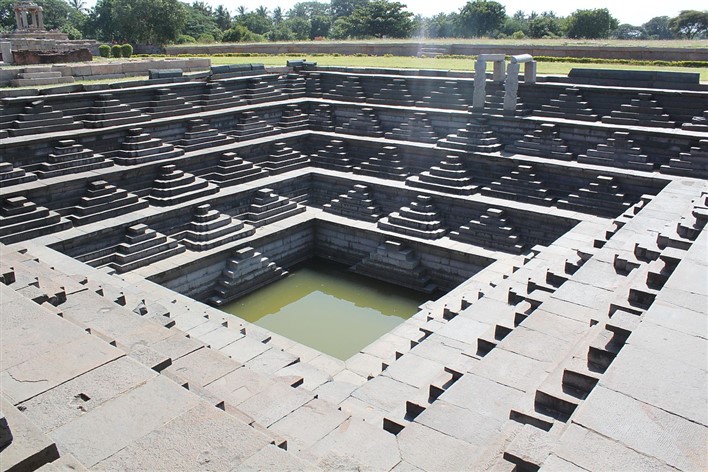
From: FEBRUARY 5, 2015 BY MADUR: Karnataka.com
Quick Facts
Timing: From morning to evening on all days of the week
Entry Fee: No entry fee required
Photography: Allowed
Video Camera: Allowed
Visit Duration: About 20 to 30 minutes for a major pushkarani
Best time to visit : From November to February
History of Pushkaranis, Hampi
The pushkaranis in Hampi are a part of the ancient town’s planning and architecture. Many of the pushkaranis were built during the time of the Vijayanagara Empire. The water tanks related to the temples were used to serve the ritualistic purposes of those temples.
There are some water tanks that are not related to the temples. Some of the water tanks are situated within the Royal Enclosure and they were built for the use of the members of the royal family of Vijayanagara. There were a few large public water tanks as well that were for use of the general people.
Purpose of Pushkaranis, Hampi
The pushkaranis in Hampi were an integral part of the people’s lives during the time of the Vijayanagara Empire. Since the temples were an important part of the social and cultural lives of the people of ancient Hampi, the water tanks also gained significance among the people.
In many cases, the water tanks served as the venue for the annual boat festivals. During such festivals, the images of Gods and Goddesses were taken out of the temples for a coracle ride on the water tanks. Sometimes the images were placed on the pavilions that can be seen in the middle of some of the pushkaranis.
Architecture of Pushkaranis, Hampi
The pushkaranis of Hampi display great architectural beauty. They are built in the typical Vijayanagara style of architecture. Many of these water tanks have beautiful rows of pillars or decorative arcade surrounding them.
The massive water tanks have large stone steps that allowed people to get into the water easily. The water tanks are connected to an extensive network of stone aqueducts and canals. These water channels were used to provide the tanks with fresh water from the Tungabhadra River. Some of these water channels are functional even today.
A Few Prominent Pushkaranis of Hampi
There are several pushkaranis in Hampi that are worth a visit even today. Many of these pushkaranis amaze visitors with their enormous sizes and rows of beautifully carved pillars surrounding them. A few pushkaranis stand out among others due to their exceptional architecture. Some of the remarkable pushkaranis of Hampi are:
The Pushkarani near the Achyuta Raya’s Temple – The pushkarani located at the end of the Courtesan’s Street or the Soolai Bazaar is considered one of the most attractive water tanks in Hampi. The water tank is presumed to be a part of the Tiruvengalanatha Temple, also known as the Achyuta Raya’s Temple.
It is a massive rectangular water tank that once had a colonnade surrounding it. The ruins of the impressive colonnade can be seen even today. An interesting thing to note is the remains of a small rectangular pillared pavilion at the centre of the tank. The water tank is in a dry state now and the gallery like steps and base are clearly visible to the visitors.
Some people believe that like many other structures in Hampi, even this water tank was destroyed in the Mughal attack that led to the downfall of the Vijayanagara Empire in 1565 A.D. Some others are of the idea that this tank’s construction was never completed. The archaeology department has restored some portions of this beautiful water tank.
The Pushkarani within the Royal Enclosure:The pushkarani located within the Royal Enclosure in Hampi is known as the Stepped Tank and is a sight to behold. It is in the south-eastern side of the Royal Enclosure. The enormous tank is an example of the rich architectural skills of the workers belonging to the Vijayanagara era.
The key attraction of the tank is the symmetrical layout of the steps. It is a 5 tiered tank where each tier comprises of a few steps. The tank is one of the most popular tourist attractions in Hampi.
The Pushkarani near the Virupaksha Temple: The pushkarani near the renowned Virupaksha Temple is known as the Manmatha Tank. It is a huge water tank that is still in a functional condition. The beautiful water tank has several shrines located near it that are popular as the Manmatha Tank Shrines.
The Pushkarani near the Vittala Temple: The pushkarani near the famous Vittala Temple is located to the east of the temple complex. The water tank can be found opposite to the ruined Kuduregombe Mantapa near the Vittala Bazaar.
The water tank is one of those tanks that are in a functional condition. However, the pillared structure surrounding the tank is in a ruined condition.
The Pushkarani near the Krishna Bazaar: The pushkarani near the Krishna Temple is also a remarkable water tank in Hampi. It is located near the Krishna Bazaar. The water tank is known for its structural beauty.
The water tank is surrounded by a pavilion with rows of carved pillars. A raised platform in the middle of the tank enhances the attraction of the tank. It is a functional tank, though some portions of the tank are in a ruined condition.
The Pushkarani near the Pattabhirama Temple: The water tank near the Pattabhirama Temple is known for its massive size. It is a ruined structure that offers glimpse of impressive architecture. The pillars surrounding the tank speak volumes about the craftsmanship of the workers of that ancient era.
Present Condition of Pushkaranis, Hampi
Many of the water tanks in Hampi are in a ruined condition today. Only a few pushkaranis can be seen in a functional state. Some of the water tanks are dry places that have remained without water for a long time now. A few among the water tanks are still full of clear water and offer a cool look to the visitors.
The pushkaranis were an integral part of the lives of the people of Hampi during the ancient times. Today they are part of the ruins of Hampi that attracts visitors from all over the world.
[edit] Pan Supari Bazaar, Hampi – Tracing a Long Lost Market Place
FEBRUARY 4, 2015 BY MADUR: Karnataka.com
The Pan Supari Bazaar is a ruined market place of Hampi. It is located in the area opposite to the main entrance of the renowned Hazara Rama Temple, the only temple situated within the Royal Enclosure of Hampi. The Pan Supari Bazaar is said to be one of the four main market places that existed during the Vijayanagara Empire.
Today the market place stands merely as a remnant of its glorious past. However, the ruined market place is still visited by a large number of tourists who love to explore the relics of the long destroyed Kingdom of Vijayanagara.
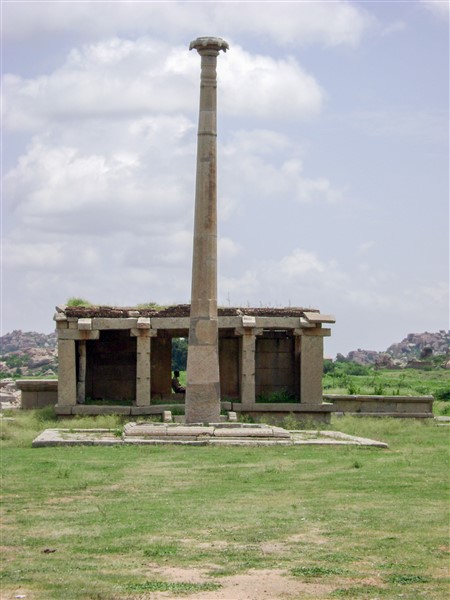
From: FEBRUARY 4, 2015 BY MADUR: Karnataka.com
Quick Facts
Timing: From dawn to dusk on all days of the week
Entry Fee: No entry fee required
Photography: Allowed
Video Camera: Allowed
Visit Duration: About 30 to 40 min
Best time to visit: From November to February
History of Pan Supari Bazaar, Hampi
The Pan Supari Bazaar is believed to have been an important market place during the reign of the Vijayanagara Empire. Though it is not clear exactly when the market place started functioning, it is thought that the Pan Supari Bazaar was a significant trading point during the peak days of Hampi.
It was a flourishing market place where traders from far off and nearby places used to gather to sell their wares. The proof of the presence of the market place indicates that the Vijayanagara Empire was truly a very wealthy kingdom that attracted traders from even far off countries and kingdoms.
The name of the Pan Supari Bazaar can be found in an inscription by Devaraya II (1424-1426 A.D.), the 9th king of the Vijayanagara Empire. Reference of the market place is also found among the writings of many people who visited Hampi from far off places during the reign of the Vijayanagara Empire.
Meaning of Pan Supari Bazaar, Hampi
The name Pan Supari Bazaar clearly indicates that it is the combination of two terms – Pan and Supari. The terms Pan and Supari refer to betel leaf and areca nut respectively. As a combined term, ‘Pan Supari’ generally means a combination of betel leaf and a mixture of areca nut, select spices, sweeteners and a paste of lime stone powder and water.
There is no clear indication why the market place near the Hazara Rama Temple was named as the Pan Supari Bazaar. One of the reasons behind the unique name of the market place may be due to the presence of a large number of areca nut plantations in the area near the Royal Enclosure.
Structure of Pan Supari Bazaar, Hampi
The Pan Supari Bazaar is an evidence of Hampi’s presence in the trade and commerce scenario during the period of time when the Vijayanagara Empire flourished in the southern part of India. It is believed that the road passing through the Pan Supari Bazaar was once a royal street that reached up to the palace entrance.
The Pan Supari Bazaar starts from the front of the Hazara Rama Temple. A tall flag post stands near the area where the ancient market place used to flourish once. A ruined gateway that leads to the Royal Enclosure can also be seen near the remnants of the Pan Supari Bazaar.
The beauty and popularity of the Pan Supari Bazaar can be estimated from the fact that the market place had several pavilions, temples and water tanks on either side of the road passing through the market. Remnants of this stretch of the road can be seen even today.
It is believed that the market place once had an impressive gateway. However, the gateway does not exist anymore. Only traces of the gateway can be found near the market place now.
Present Condition of Pan Supari Bazaar, Hampi
The Pan Supari Bazaar is in a state of ruins today. The once-glorious market place is no longer functional. In fact, the exact position of this ancient market place can be seen more clearly on the maps of Hampi than in the real world. Just some portions of the market place can be seen among the ruins.
The battered market place can be counted as one of those structures and monuments in Hampi that suffered extensive destruction during the fierce attack of the Deccan Sultanates on the Vijayanagara Empire in 1565 A.D. The widespread ruins, broken structures and destroyed pavilions fill up the location of the once beautiful market place that was always teeming with buyers and sellers.
Even the gateway near the market place is in a ruined condition and only the basement remains today.
[edit] Granaries, Hampi – Remnants of Ancient Storages
JANUARY 26, 2015 BY MADUR: Karnataka.com
The Granaries in Hampi are ancient structures that were used as storages during the reign of the Vijayanagara Empire. The granaries or their ruins are located across various places in Hampi. One of the locations for the ruins of large granaries in Hampi is near the Hazara Rama Temple in the Royal Enclosure.
The granaries were used as storage places to stock up huge quantities of grains. The size of the ruined granaries in Hampi indicates that they served as the public granaries during the days of the Vijayanagara Empire.
The granaries are one of the many attractions for the tourists visiting Hampi to have a look at the ruins of the Vijayanagara Empire.
Quick Facts
Timing: From morning to evening on all days of the week
Entry Fee: No entry fee required
Photography: Allowed
Video Camera: Allowed
Visit Duration: Generally about 20 to 30 minutes (For a particular location of the granaries)
Best time to visit : From November to February
History of Granaries, Hampi
The granaries of Hampi dates back to the days of the Vijayanagara Empire. The presence of a large number of granaries and other structures and artefacts related to the granaries signify that they were a common feature during the reign of the Vijayanagara Kings.
A remarkable fact to note is that even in that ancient age, the Kings of Vijayanagara took care for proper storage of grains. They built huge granaries in various locations across Hampi and in other places of their kingdom to preserve enormous quantities of grains for future use.
Some of the granaries in Hampi are believed to be associated with the temples while others are thought to have been for general use or non-religious use. This shows the importance of temples in the social life of the people in Hampi during the days of the Vijayanagara Empire.
Utility of Granaries
A granary is a storage place or a store house that is used to stock up grains for future use. In the ancient days, the kings and the administrators of the kingdoms used to build huge granaries to store food grains in bulk and protect them against the attack of mice, insects or other such elements.
The granaries were a place to preserve food grains to counter extreme or unforeseen conditions like scarcity, draught, war, famine, etc. Several precautions were taken to keep the grains in good condition while they were in the granaries.
Structure of the Granaries in Hampi
Remnants of several granaries have been found in many places in Hampi. The characteristic feature of these granaries is that they are huge in size. The granaries were built with blocks of large stones, as was the common practise followed in Hampi during the ancient times.
The ruins of several huge granaries in Hampi point towards the fact that large public granaries were a common feature of Hampi. They were part of the town planning done for Hampi.
The granaries in Hampi were mainly of two shapes – Circular and Cubical.
Circular Granaries: These were round shaped storage places that were built above the ground. The size of such granaries gives an idea about the huge amount of grains that were stored in them.
Cubical Granaries: These were cube shaped granaries that were built with deep foundations into the ground. The cubical granaries were arranged in an array of identical rows.
Present Condition of Granaries, Hampi
The granaries in Hampi are no longer the intact storage places that were once used to store grains. They have been destroyed long ago, just like most other structures and monuments in Hampi. Today only the ruins and remnants of the granaries can be seen in Hampi.
There are several places where the foundations of the granaries can still be seen in the ruined town of Hampi. These foundations provide an idea about the planning and administrative qualities of the Vijayanagara kings and the efforts they took to run the kingdom smoothly.
[edit] Elephant Stable, Hampi
JANUARY 25, 2015 BY MADUR: Karnataka.com
The Elephant Stable in Hampi is an impressive structure that was used to provide shelter for the royal elephants of the Vijayanagara Empire. The elephant stable is located in the area that lies just outside the Zenana Enclosure.
It is one of the very few structures that have not suffered extensive damage during the Mughal attack on Hampi that led to the downfall of the Vijayanagara Empire in 1565 A.D. The ancient stable is a major attraction among the tourists even today.
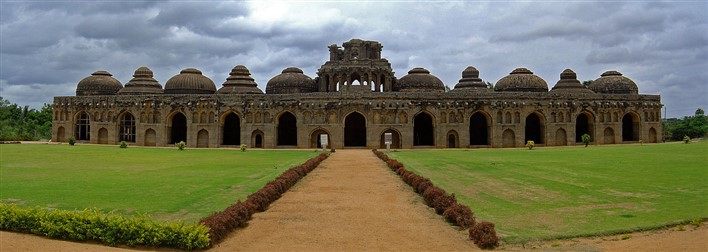
From: JANUARY 25, 2015 BY MADUR: Karnataka.com
Quick Facts
Timing: 8:30 AM to 5:30 PM on all days of the week
Entry Fee for Indians: INR 10.00
Entry Fee for Foreigners: INR 250.00
Entry Fee for Children: Free for Children under 15 years of age
Photography: Allowed (no extra charges levied)
Visit Duration: Around 1 hour
Best time to visit: From November to February
History of Elephant Stable, Hampi
The elephant stable was constructed in the 15th century, during the reign of the Vijayanagara Empire. As the name indicates, the stable was constructed to house the royal elephants of the Vijayanagara Empire.
The elaborate structure indicates the importance attached to the royal elephants during those days. It also suggests towards the amazing craftsmanship of the artisans of that era.
Impressive Architecture of Elephant Stable, Hampi
The elephant stable in Hampi is one of the finest examples of Indo-Islamic style of architecture. Though most of the structures and monuments in Hampi were built using the Vijayanagara style of architecture, a few structures display the Indo-Islamic style as well.
The elephant stable is a prominent building in Hampi that displays this beautiful architectural style.
The elephant stable is a long building with a rectangular shape. The building has a row of eleven huge domed chambers. Each chamber is large enough to accommodate two elephants at a time. The domed chambers are interconnected with large arched openings.
The walls between the arches have small doorways. There is no sign to indicate that the chambers ever had any doors in the doorways.
Every chamber contains a small opening at the rear side. It is believed that this opening was used by the mahouts to enter and exit the chambers.
The building also contains a concealed staircase that leads one to the roof of the building. The chambers of the building have high ceilings.
The central chamber contains a metal hook embedded in the ceiling. This hook was most probably used to tie the elephants during the days of the Vijayanagara Empire. The hook could also have been used as a pulley by the mahout to set the howdah on the back of the elephants.
Uniqueness of domes in Elephant Stable, Hampi
The uniqueness about the elephant stable is that it has a distinct central dome. The central dome is the largest and most decorated among the 11 domes of the building. The design of the central dome represents the architectural style found in the temples of Hampi.
The other 10 domes represent the Islamic style of architecture. The domes of the building were designed in a variety of shapes, such as, octagonal, circular, ribbed, drum-shaped and fluted. All the domes possess a symmetric layout. Each of the domes was decorated with ornate plaster on the interior as well as the exterior.
Present Condition of the Elephant Stable, Hampi
The elephant stable is among one of the few least destroyed buildings in Hampi. The wear and tear of time and weather has faded and weakened the building to an extent. However, it is still in a firm condition, more than 600 years after it was constructed.
The plaster of the building has fallen off at some places. The central dome is not as well preserved as the other domes. Yet, the stable stands as one of the most remarkable structures in Hampi and attracts scores of visitors on a daily basis. It is one of the monuments that are preserved by the Archaeological Survey of India.
[edit] Laidback glory
India Today December 19, 2008
The ruins of the glorious Vijayanagar Dynasty are now heritage spots and quaint trails. Hemakuta Hill holds breathtaking sunrises and sunsets. Hampi is also the backpacker’s delight. The openair restaurant Under the Mango Tree is aptly located under a mango tree. For souvenirs, there’s the quaint but charming town of Anegundi.
[edit] World’s no.2, India’s no.1 destination/ 2019
The ruins of Hampi in Ballari district, which under the Vijayanagar Empire thrived as one of the richest towns during the 16th century, has been ranked second among the must-see global destinations as per New York Times list of ‘52 Places To Go In 2019’.
[edit] UNESCO’s citation
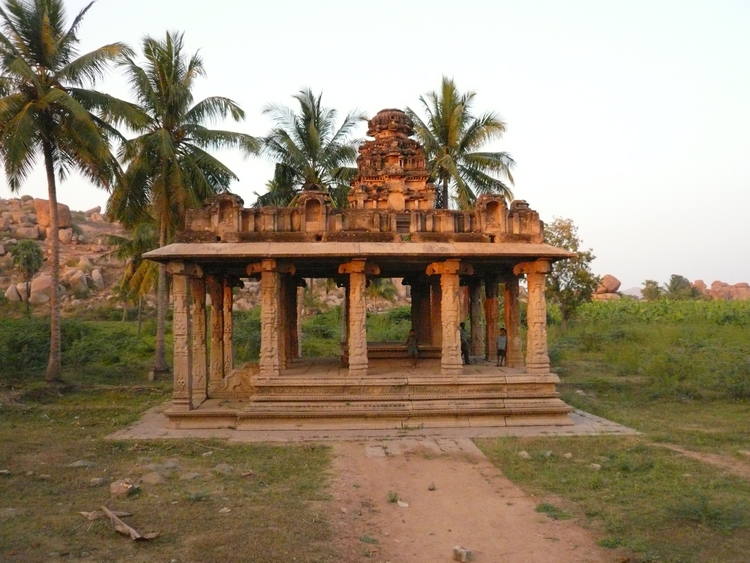
From: Group of Monuments at Hampi: The United Nations Educational, Scientific and Cultural Organization (UNESCO) and World Heritage Convention
Group of Monuments at Hampi
The austere, grandiose site of Hampi was the last capital of the last great Hindu Kingdom of Vijayanagar. Its fabulously rich princes built Dravidian temples and palaces which won the admiration of travellers between the 14th and 16th centuries. Conquered by the Deccan Muslim confederacy in 1565, the city was pillaged over a period of six months before being abandoned.
Outstanding Universal Value
Brief synthesis
The austere and grandiose site of Hampi comprise mainly the remnants of the Capital City of Vijayanagara Empire (14th-16th Cent CE), the last great Hindu Kingdom. The property encompasses an area of 4187, 24 hectares, located in the Tungabhadra basin in Central Karnataka, Bellary District.
Hampi’s spectacular setting is dominated by river Tungabhadra, craggy hill ranges and open plains, with widespread physical remains. The sophistication of the varied urban, royal and sacred systems is evident from the more than 1600 surviving remains that include forts, riverside features, royal and sacred complexes, temples, shrines, pillared halls, Mandapas, memorial structures, gateways, defence check posts, stables, water structures, etc.
Among these, the Krishna temple complex, Narasimha, Ganesa, Hemakuta group of temples, Achyutaraya temple complex, Vitthala temple complex, Pattabhirama temple complex, Lotus Mahal complex, can be highlighted. Suburban townships (puras) surrounded the large Dravidian temple complexes containing subsidiary shrines, bazaars, residential areas and tanks applying the unique hydraulic technologies and skilfully and harmoniously integrating the town and defence architecture with surrounding landscape. The remains unearthed in the site delineate both the extent of the economic prosperity and political status that once existed indicating a highly developed society.
Dravidian architecture flourished under the Vijayanagara Empire and its ultimate form is characterised by their massive dimensions, cloistered enclosures, and lofty towers over the entrances encased by decorated pillars.
The Vitthla temple is the most exquisitely ornate structure on the site and represents the culmination of Vijayanagara temple architecture. It is a fully developed temple with associated buildings like Kalyana Mandapa and Utsava Mandapa within a cloistered enclosure pierced with three entrance Gopurams. In addition to the typical spaces present in contemporary temples, it boasts of a Garuda shrine fashioned as a granite ratha and a grand bazaar street. This complex also has a large Pushkarani (stepped tank) with a Vasantotsava mandapa (ceremonial pavilion at the centre), wells and a network of water channels.
Another unique feature of temples at Hampi is the wide Chariot streets flanked by the rows of Pillared Mandapas, introduced when chariot festivals became an integral part of the rituals. The stone chariot in front of the temple is also testimony to its religious ritual. Most of the structures at Hampi are constructed from local granite, burnt bricks and lime mortar. The stone masonry and lantern roofed post and lintel system were the most favoured construction technique. The massive fortification walls have irregular cut size stones with paper joints by filling the core with rubble masonry without any binding material. The gopuras over the entrances and the sanctum proper have been constructed with stone and brick. The roofs have been laid with the heavy thick granite slabs covered with a water proof course of brick jelly and lime mortar.
Vijayanagara architecture is also known for its adoption of elements of Indo Islamic Architecture in secular buildings like the Queen’s Bath and the Elephant Stables, representing a highly evolved multi-religious and multi-ethnic society.Building activity in Hampi continued over a period of 200 years reflecting the evolution in the religious and political scenario as well as the advancements in art and architecture. The city rose to metropolitan proportions and is immortalized in the words of many foreign travellers as one of the most beautiful cities. The Battle of Talikota (1565 CE) led to a massive destruction of its physical fabric.
Dravidian architecture survives in the rest of Southern India spread through the patronage of the Vijayanagara rulers. The Raya Gopura, introduced first in the temples attributed to Raja Krishna Deva Raya, is a landmark all over South India.
Criterion (i): The remarkable integration between the planned and defended city of Hampi with its exemplary temple architecture and its spectacular natural setting represent a unique artistic creation.
Criterion (iii): The city bears exceptional testimony to the vanished civilization of the kingdom of Vijayanagara, which reached its apogee under the reign of Krishna Deva Raya (1509-1530).
Criterion (iv): This capital offers an outstanding example of a type of structure which illustrates a significant historical situation: that of the destruction of the Vijayanagara kingdom at the Battle of Talikota (1565 CE) which left behind an ensemble of living temples, magnificent archaeological remains in the form of elaborate sacred, royal, civil and military structures as well as traces of its rich lifestyle, all integrated within its natural setting.
Integrity
The area of the property is adequate to accommodate, represent and protect all the key attributes of the site.
The majority of the monuments are in good state of preservation and conservation. The highly developed and extremely sophisticated settlement articulates architectural manifestations, agricultural activities, irrigation systems, formal and informal paths, boulders and rocks, religious and social expressions. However, maintaining these conditions of integrity poses significant challenges derived mainly from pressures associated with development, planned and unplanned, which pose a threat to the landscape of the property, as well as encroachments and changes in land use, especially increased agricultural activity of commercial crops that might threaten the physical stability of the diverse monuments.
Particular attention will need to be placed on regulating residential constructions and potential development to accommodate visitor use, as well as infrastructure to address communication needs, particular by pass roads. Addressing also the visual impact of modern electrification fixtures, telephone poles and other elements, will also be important to maintain the integrity of the property.
Authenticity
The attributes like strategic location and abundance of natural resources, rendering this spectacular landscape befit for a Capital City have been maintained in the property.
The authenticity of the site has been maintained in terms of location and setting, as the original setting comprising of river Tungabhadra and boulders is fully retained. In terms of form and function, the integration of the geographic setting with man-made features in the design and functional layout of the entire capital can still be discerned and the form of the original city planning with suburban pattern is evident. The largely untouched archaeological elements provide ample evidences of authentic materials and construction and interventions have maintained qualities when undertaken. The stages of evolution and perfection of the Vijayanagara Architecture are evident in the monumental structures As for traditions and techniques; the physical remains are a befitting tribute to the ingenuity of the builders in shaping the metropolis of this grand scale by utilizing locally available material, traditional knowledge system and skilled craftsmanship. Today there is a continuity of several religious rituals, associations, traditional skills and occupations within the society that have been maintained.
However, the destruction by the battle of Talikota and the passage of time have led to some of the original functions and traditions becoming obsolete and altered, while several are in continuum forming an integral part of the site like festivals, temple rituals, pilgrimage, agriculture, etc. The Virupaksha temple is in constant worship, this has led to many additions and alterations to different parts of temple complex. Similarly, the haphazard growth of modern shops, restaurants in and around it and its bazaar that caters to religious and social tourists has impacted adversely on its setting as has the asphalting of the roads over the ancient pathway in front of the Virupaksha temple. The tensions between modern uses and protecting the fabric and setting of the ancient remains need to be managed with the utmost sensitivity.
Protection and management requirements
Different legal instruments exist for the protection of the property, including the Ancient Monuments and Archaeological Remains and Sites Act, 1958 (AMASR Act, 1958), AMASR (Amendment and Validation) Act, 2010 and Rules 1959 of the Government of India and Karnataka Ancient and Historical Monuments and Archaeological Sites and Remains Act, 1961. Recently, the Draft (Bill) of Hampi World Heritage Area Management Authority Act, 2001 has been framed to look after the protection and management of the 4187,24 hectares of the World Heritage Area.
There are different levels of authorities and agencies that have mandates that influence the protection and management of the property under a diversity of Acts. The Government of India, the Archaeological Survey of India (ASI) and the Government of Karnataka are responsible for the protection and management of fifty-six Nationally Protected Monuments and the rest of the area covered by 46.8 sq. kms respectively under their respective legal provisions. The ASI has established site office at Kamalapuram to manage the Centrally Protected Monuments. It is also functioning as World Heritage Site Co-ordinator at the local level and district level interacting with various local self Government and district authorities and the Hampi Development Authority for preserving the values of the property. The regional level office at Bangalore, which co-ordinates with Directorate, ASI, New Delhi and concerned agencies of the Government of Karnataka at higher level, supports the ASI site office at Kamalapur.
Office of the Director General, ASI, New Delhi office is a national apex body coordinating with UNESCO on one hand and the regional offices under whose jurisdiction the World Heritage Property falls and also the highest authorities of the Government of Karnataka on the other. The DAM has its office at Mysore and local office at Hampi. The HUDA, HWHAMA, Town Planning and other district level authorities are located in Hospet and Bellary, which is also the Head Quarters of the Deputy Commissioner. The management of other aspects of the property such as the cultural landscape, living traditions, rest with State, Town, Municipal and Village level agencies.
The constitution of a single heritage authority, Hampi World Heritage Area Management Authority (HWHAMA) ensure the effectiveness of the management system and coordination of works from different agencies while allowing local self Government authorities to continue to exercise the powers as enlisted in the respective Acts. The final powers for approving and regulating any developmental activities in the property rest with the HWHAMA. The establishment of the Integrated Information Management Centre and initiation of the Joint Heritage Management Program are major steps towards effective protection and management within the Indian legal frame work.
The present perspective acknowledges its diverse attributes and complex cultural systems. The management framework visualizes the site in its entirety where heritage management is the first priority followed by human resource development, which elevates the economic status. The implementation of the Integrated Management Plan aims at value-based management and ensures safeguarding of the outstanding universal value of the property.
Specific long, mid and short term goals for ensuring effective management of the property have been identified and their implementation processes are in various stages. The periodic review and update of management tools including the Master Plan, the Base Map on the GIS platform, the Conservation Plan, the Risk Preparedness Plan, the Public Use plan, and other tools to ensure sustainable development of the local community and also reduce the risk from natural and human made disaster in different areas of the property, is critical to ensure the sustainability of the management system. Long-term goals include internal capacity building and adoption of a new systematic approach where actions are coordinated and participatory. Sustained funding will be essential to ensure an operational system and the allocation of resources for the implementation of projects for the conservation and management of the diverse elements of the property.
[edit] After 1947
[edit] 1947- 2019
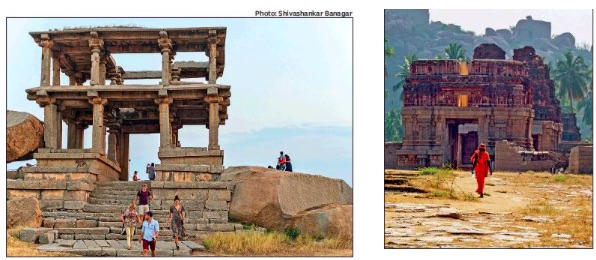
Photo: Shivashankar Banagar
From: Sangamesh Menasinakai, Hampi stands on more than the pillars miscreants pulled down, February 9, 2019: The Times of India
Once obscure pilgrimage site now hogs global spotlight
Along a distance of 12 km eastwards from the city of Hospet in Karnataka, local residents have a term for what lies at the end of the journey: ‘haalu Hampi’. It means ‘ruined Hampi’. For generations, the 14th century capital of the Vijaynagara Empire, with extraordinary architectural and historical treasures, had been just a place of ruin and desolation. But 30 years after it saw a revival in tourism, Hampi is now the focus of global attention, with the New York Times placing it second in the list of must-visit places in the world.
On March 1, 2018, under the Centre’s regional air connectivity scheme UDAN, flights started from Bengaluru to Ballari, from where Hampi is 62 km away. This is expected to increase connectivity to the monument complex. But all this – and an international profile -- has not come easily for Hampi.
The site is vast, spread over 41 sq km, containing more than 1,800 buildings, markets, fortifications, ponds and temples, with a history of settlement going back to the Mauryan Empire. Ashokan rock edicts have been found at Nittur and Udegolam, near the city complex. In 1565, a coalition of Muslim sultanates defeated Vijayanagara and sacked the city. It was only in 1856 that it was re-discovered, by Alexander Greenlaw of the East India Company.
In later years, Hampi became mainly a pilgrimage site for the people of the region. The only other visitors were those familiar with the history of the place, and there were little employment opportunities for anybody.
“When I was young, the only time my parents could earn well was during festivals. We could get about Rs 2,000 during these times -- a lot of money in the 1980s. The rest of the year, it was a hand-to-mouth existence,” said A Krishnam Raju, whose parents emigrated to Hampi to sell incense sticks.
“Things changed from 1990 onwards. Now there are at least 100 members of 30 families related to me in the hospitality industry here,” Raju, who owns a restaurant, added.
In 1988, UNESCO declared Hampi a world heritage site, which led to a boost in the number and type of tourist arrivals. By then, Dutch artist Robert Geesink had been living in the area for nearly two decades, and would stay for two more decades. “He motivated us to consider expanding our services to tourists. Hampi was becoming more than a pilgrimage spot. Now I have 30 employees at my restaurant,” Raju added.
Sripada Pathikonda, secretary, Tourism Entrepreneurs’ Association, Hosapete, said there were 6 or 7 hotels in Hosapete a decade ago. “Now we have 50 and can accommodate 2,000 guests per day. Many unauthorised home stays and hotels have also come up,” he added.
ASI has recognized 57 monuments here as World Heritage Sites and state archaeological department another 1,800. ASI has also formed a separate Hampi Mini Circle from Sept 5, 2014 for up-keep.
Hampi may have seen the most remarkable turnaround for any tourist site in the country in the recent past, but problems remain. A video which was widely circulated online at the beginning of February showed some youths toppling reconstructed pillars near a Vishnu temple. Locals have alleged that lax protection of the sites by ASI is to blame. A team of archaeologists, police officers and district administration officials have surveyed the damage and recommended that the ASI increase the number of CCTV cameras in the complex and tighten security arrangements.
Locals have other issues as well with the manner in which the site is administered. “Hampi was protected by local residents much before ASI was formed. Now citing ASI norms and alleging illegal activities, authorities are trying to evict us,” said M Swati Singh of Hampi gram panchayat, which includes 73 individual households and claims ownership of Virupaksha temple, a protected monument. Villagers have gone to court against the move.
In other cases, experts have expressed objections. Fencing has been erected around many sites and monuments. “This looks odd and diminishes the look of heritage sites. There is a stone wall near a site called Queen’s Bath. If you put up fencing between connected sites, it throws away context and meaning,” said Vasudevan CS, professor of ancient history and archaeology, Kannada University at Hampi.